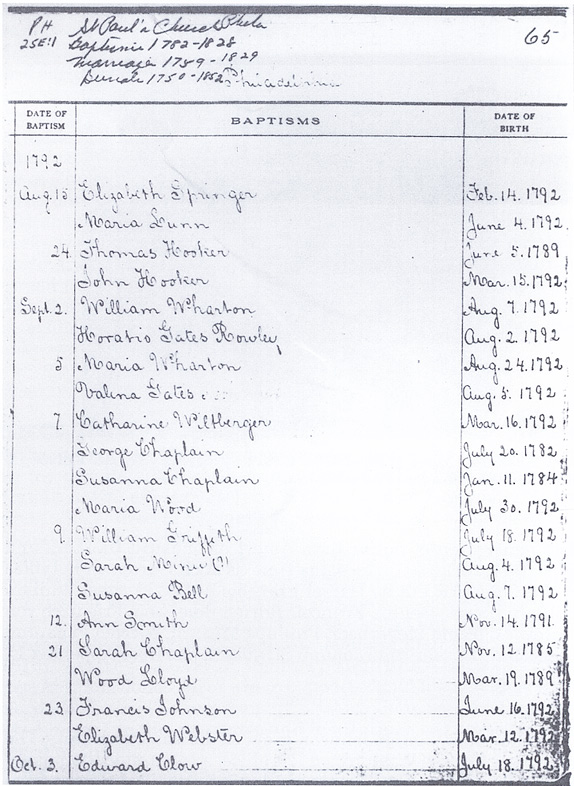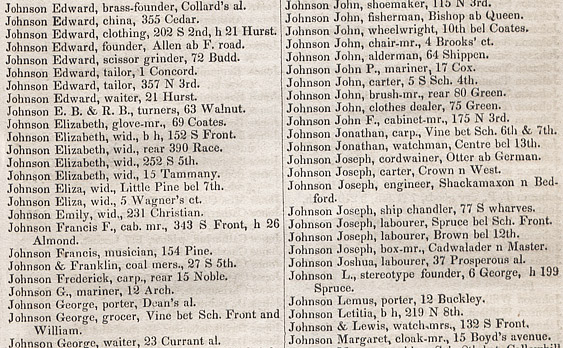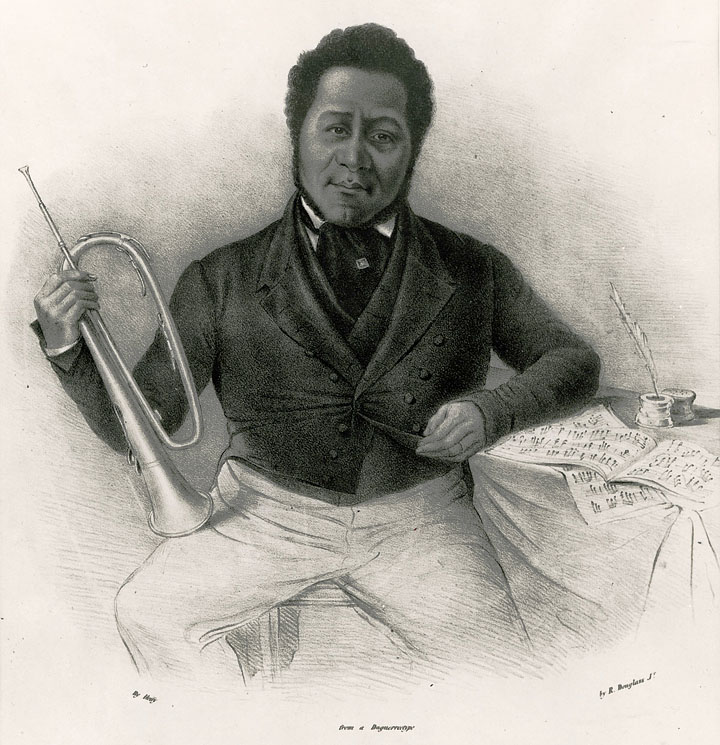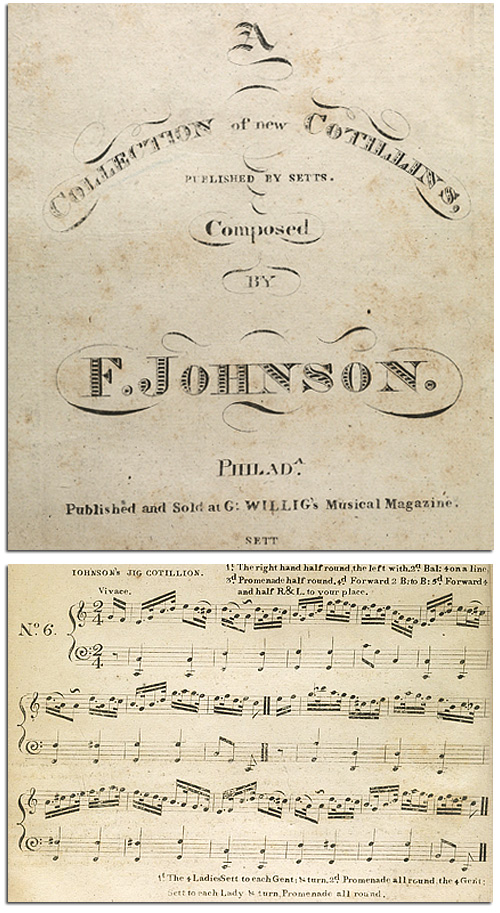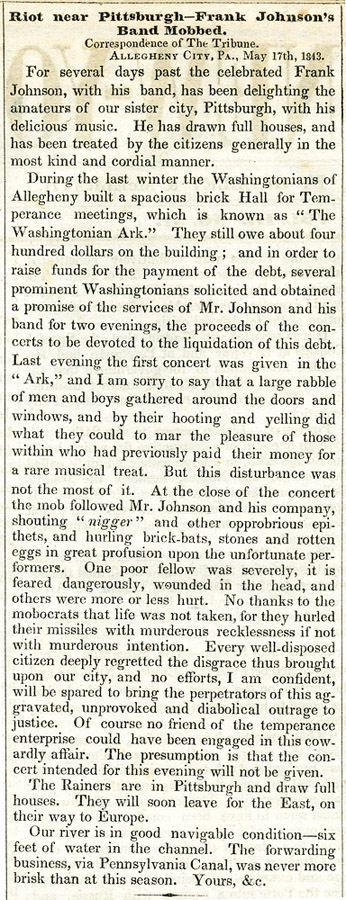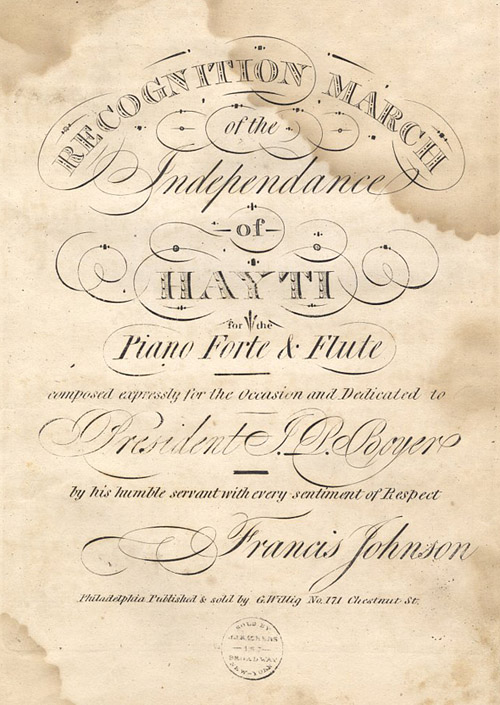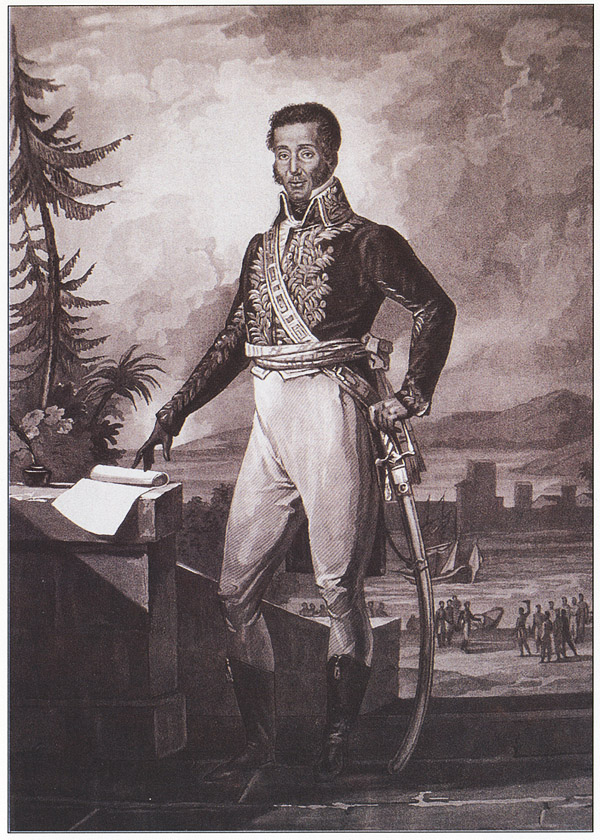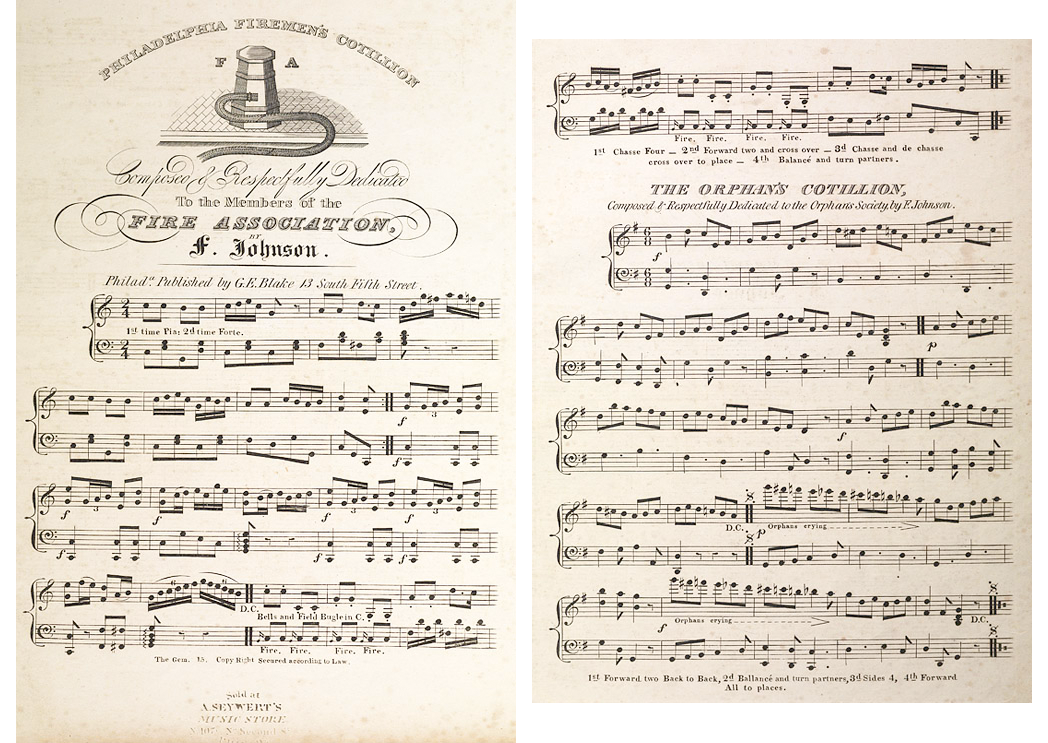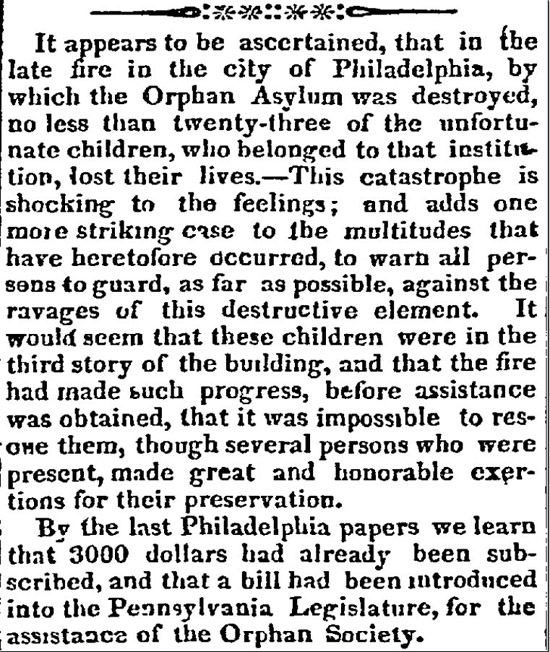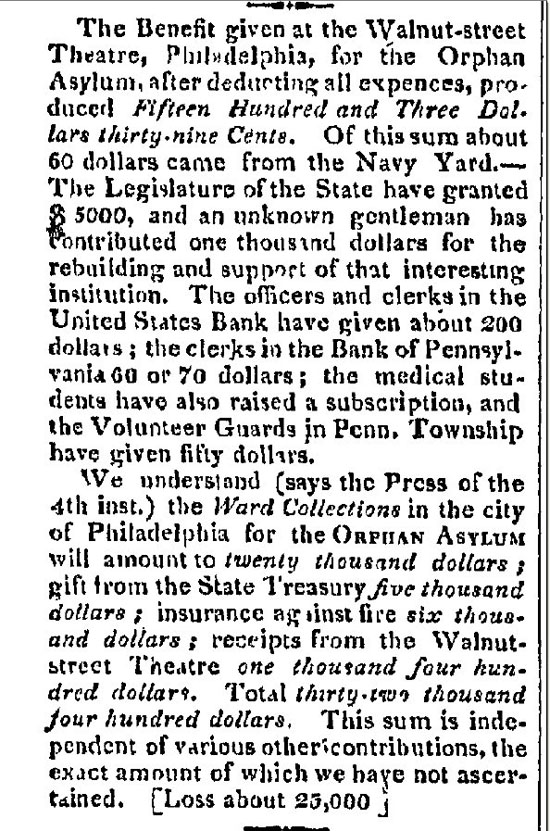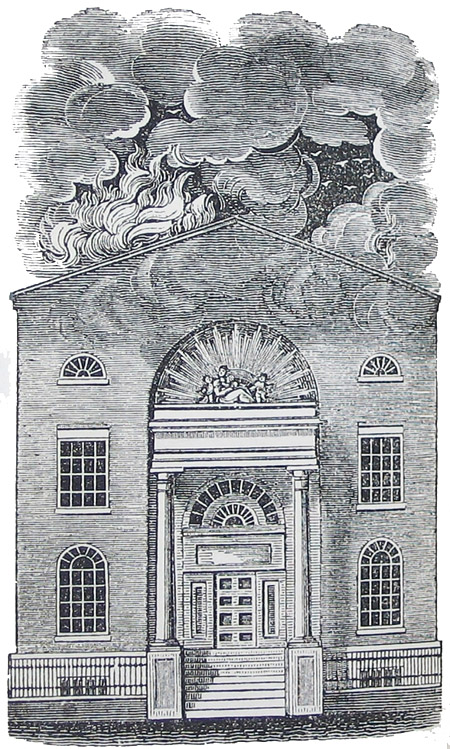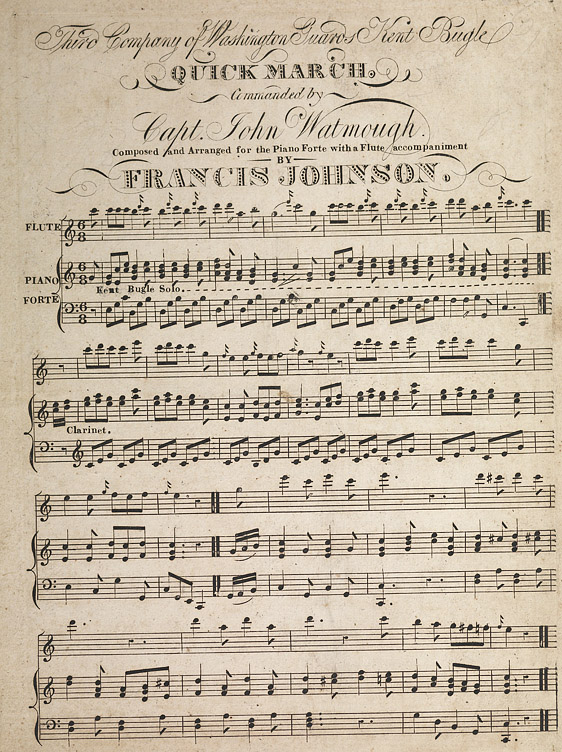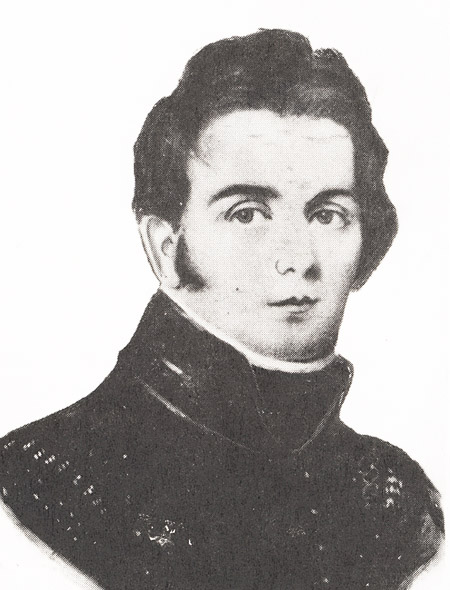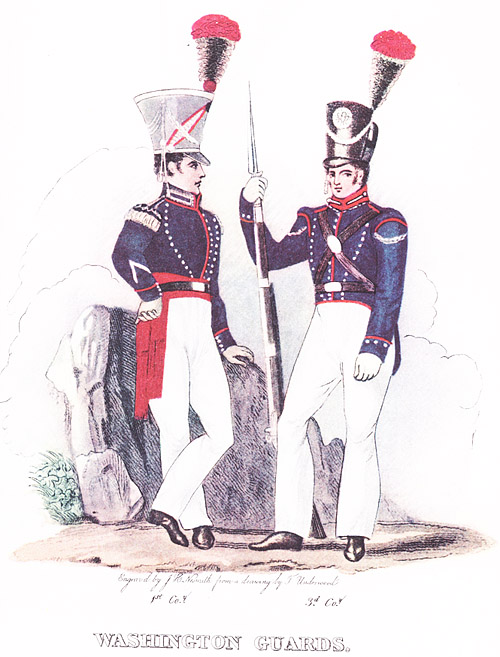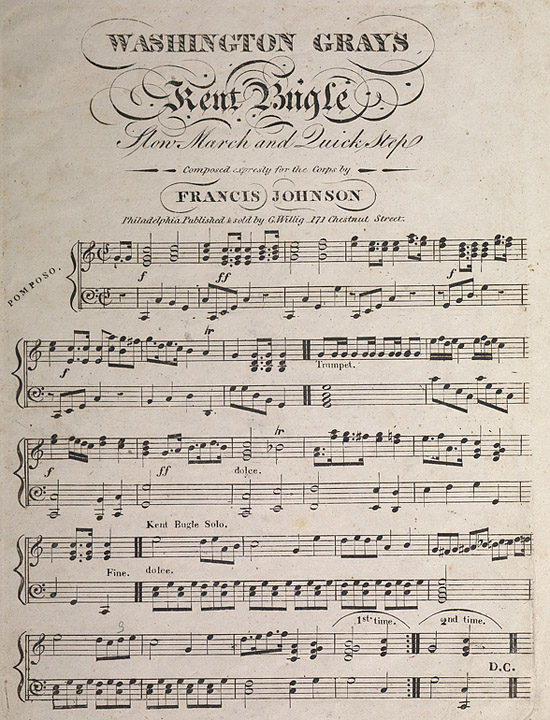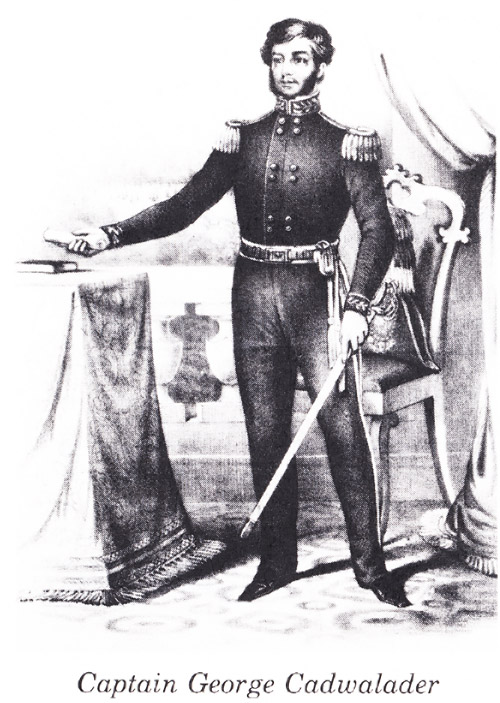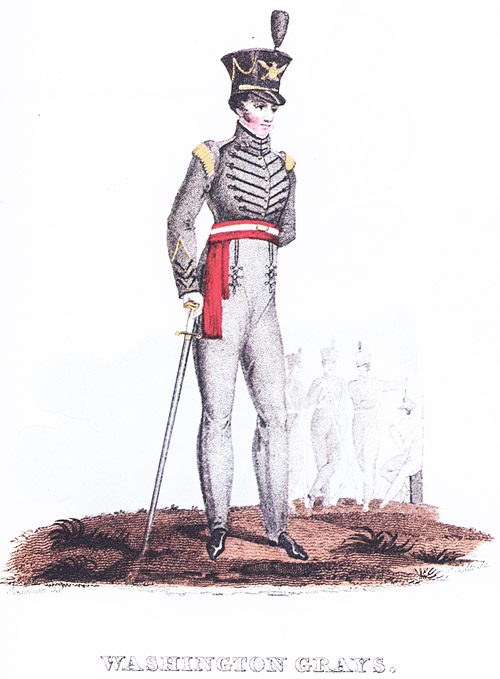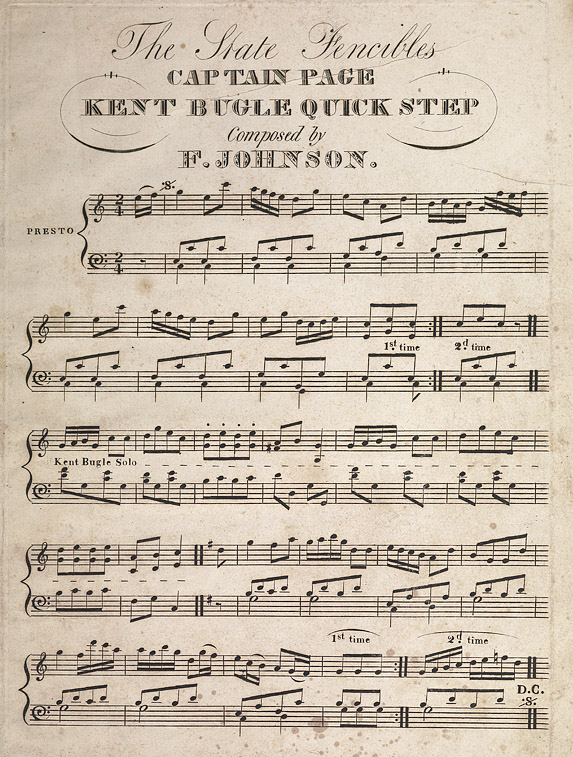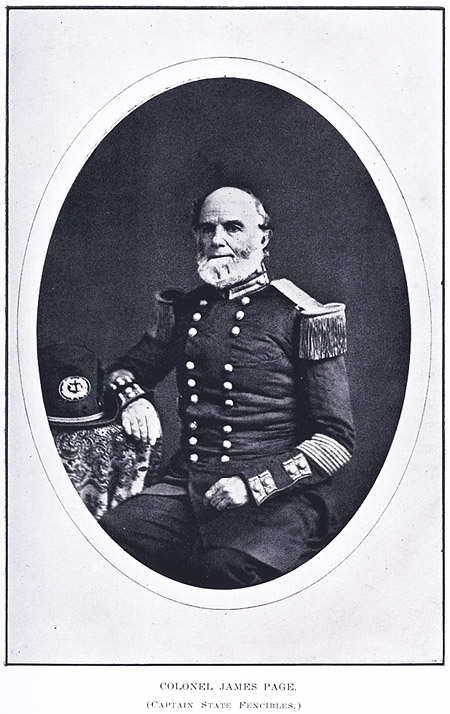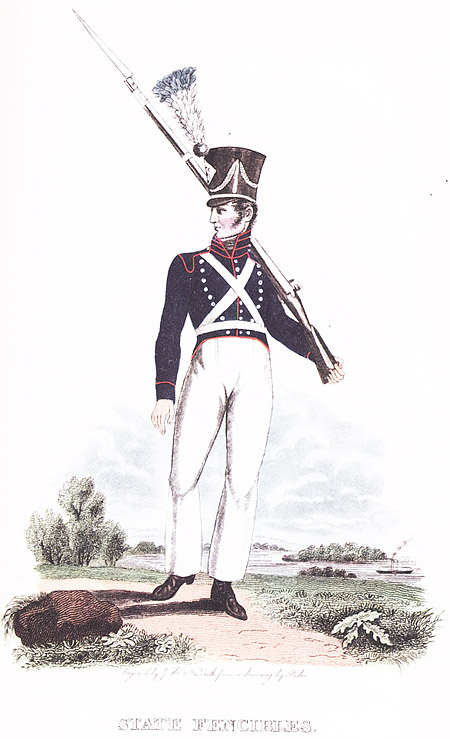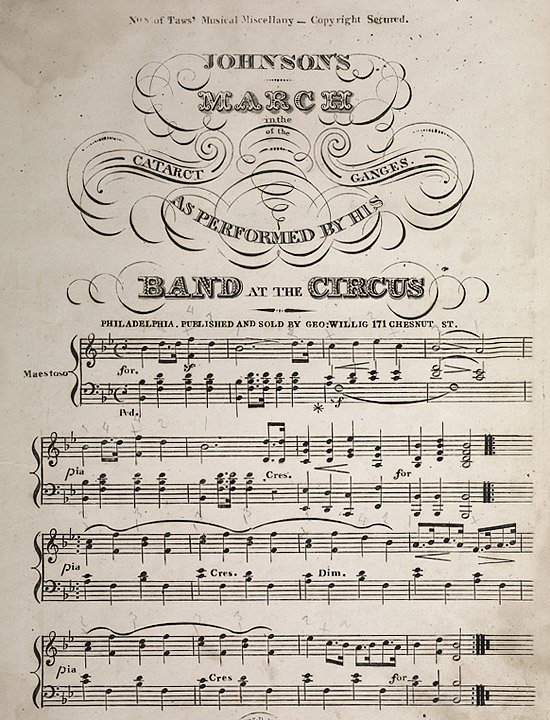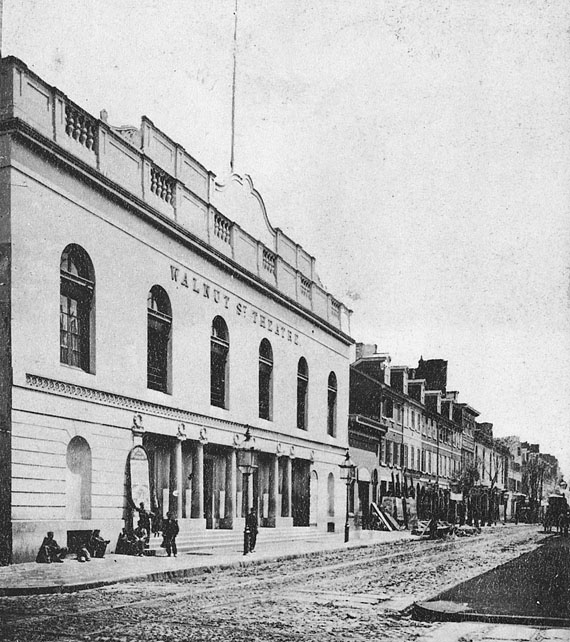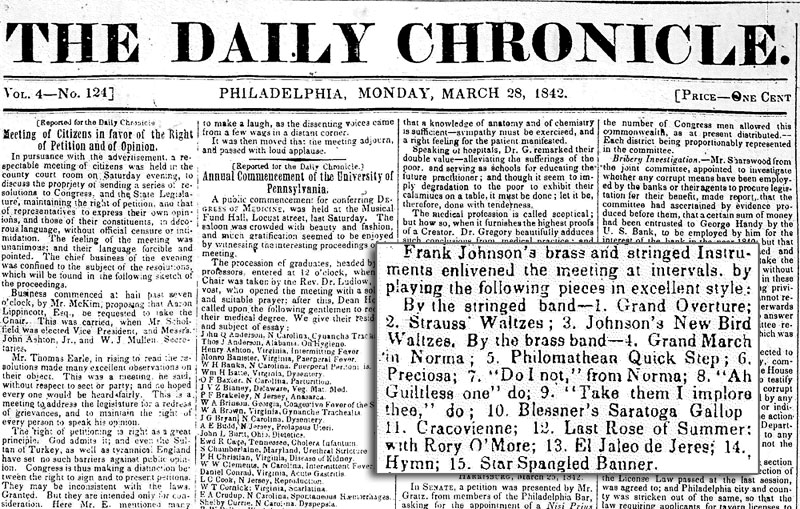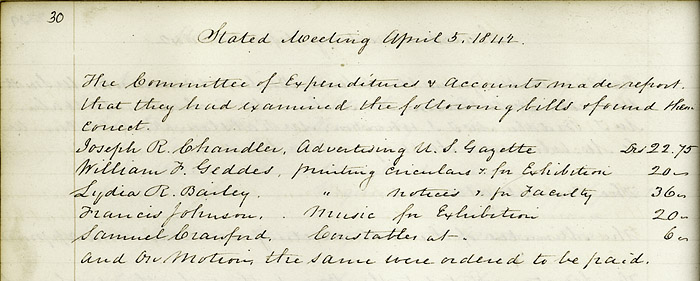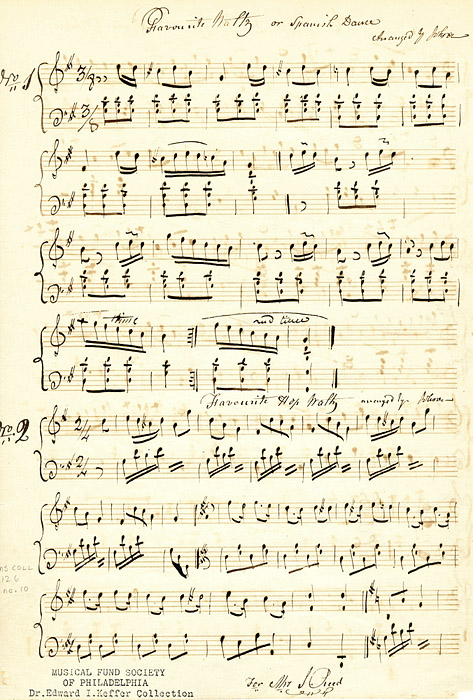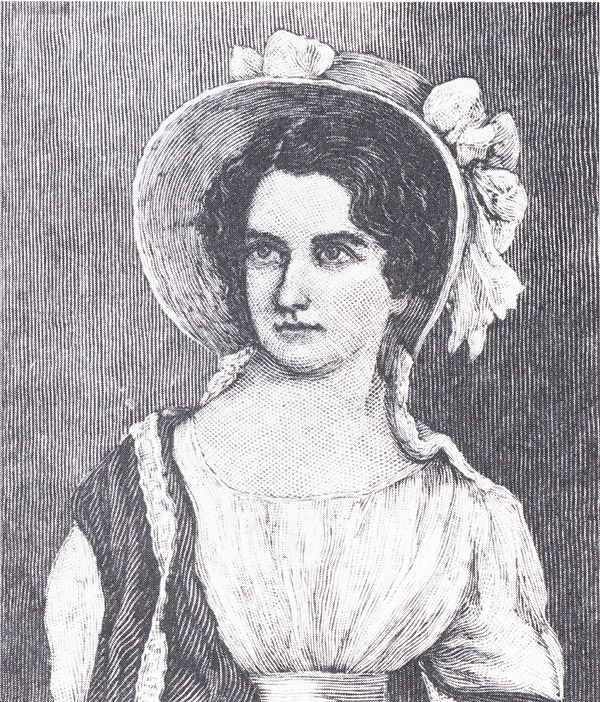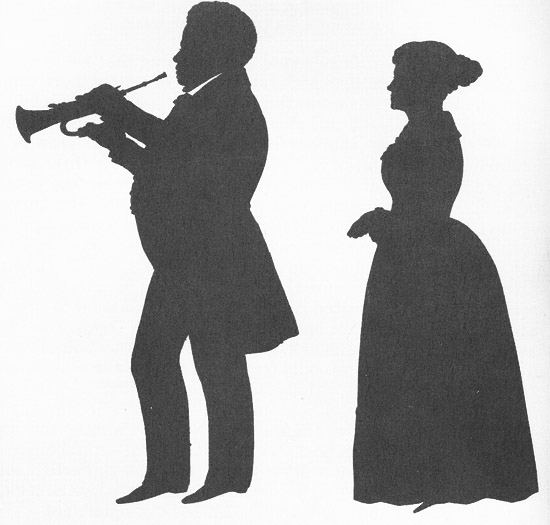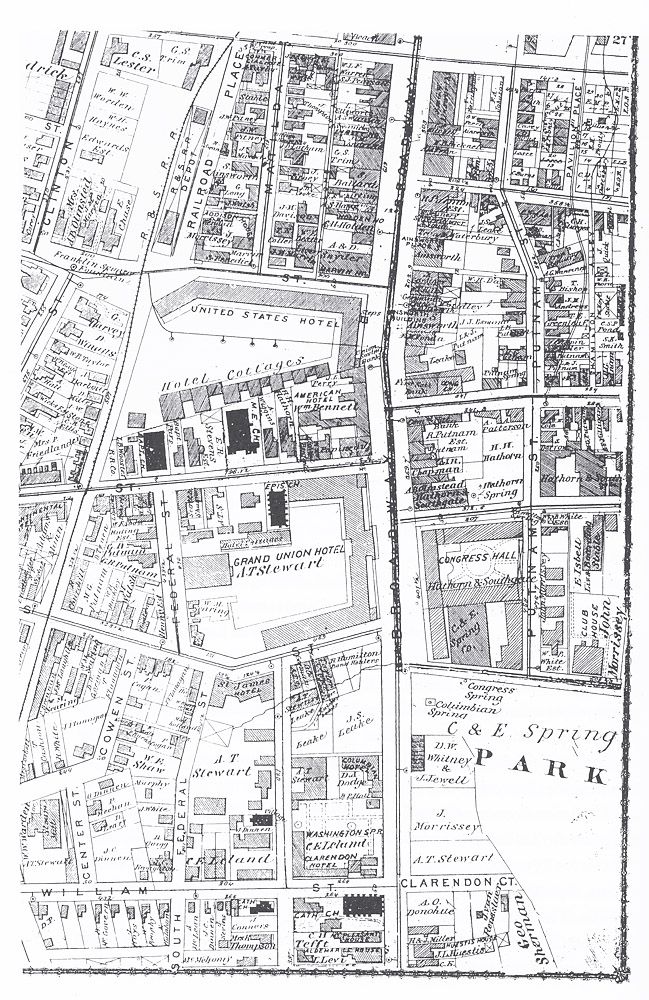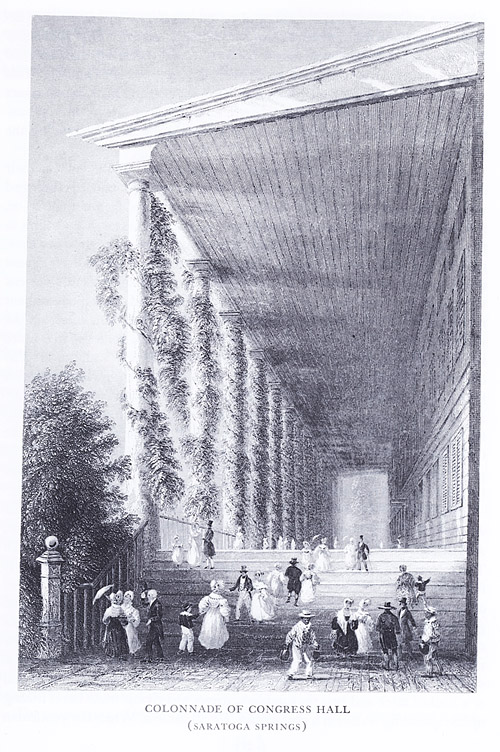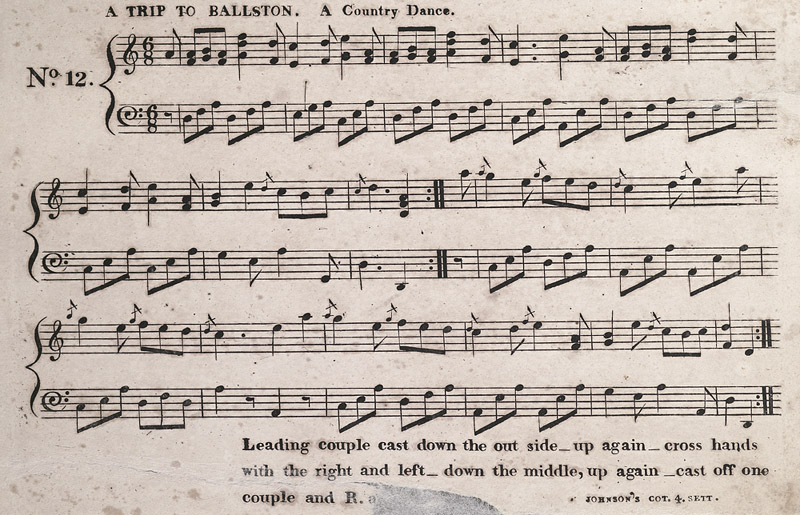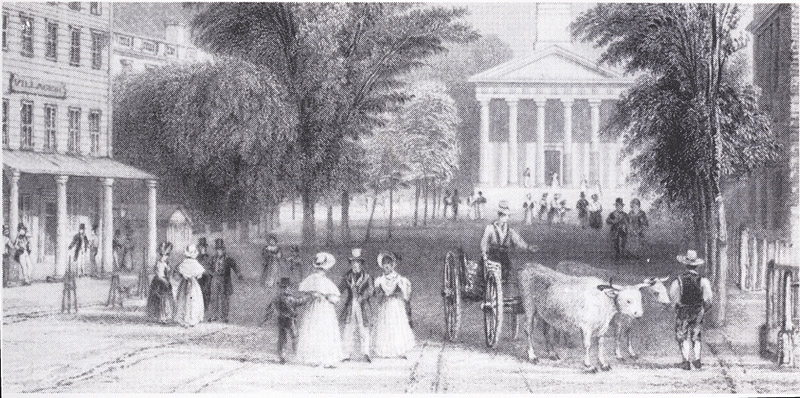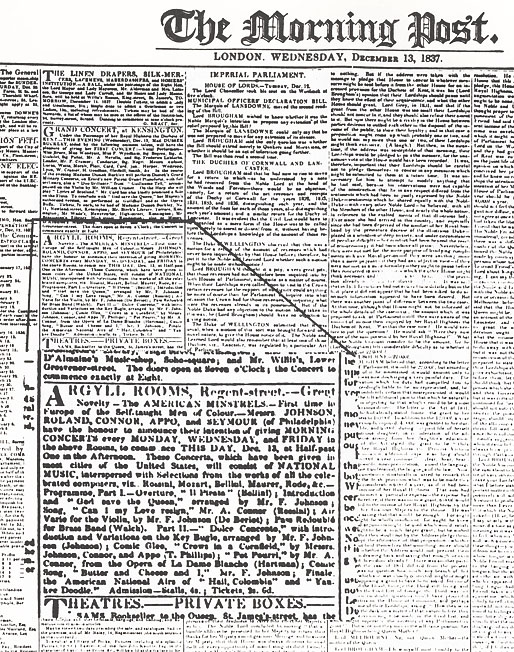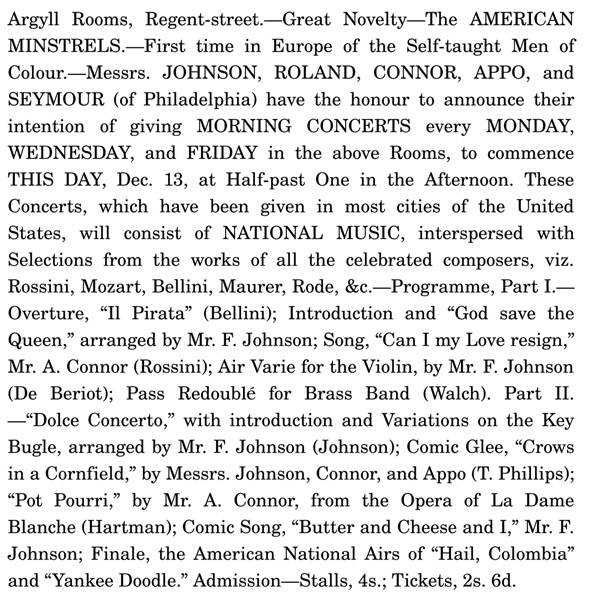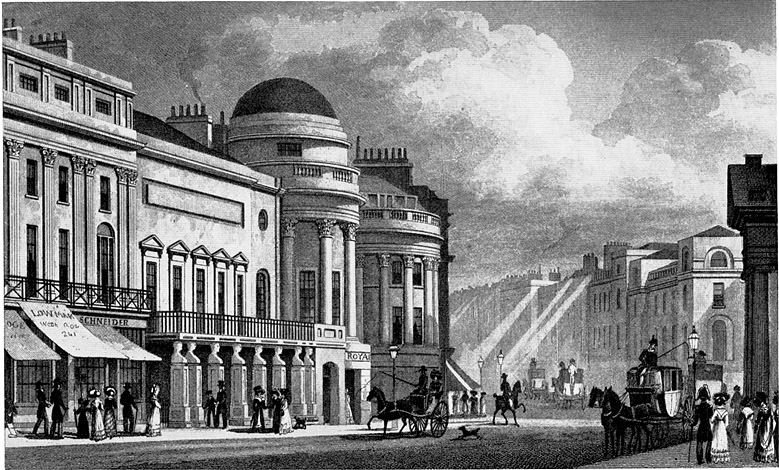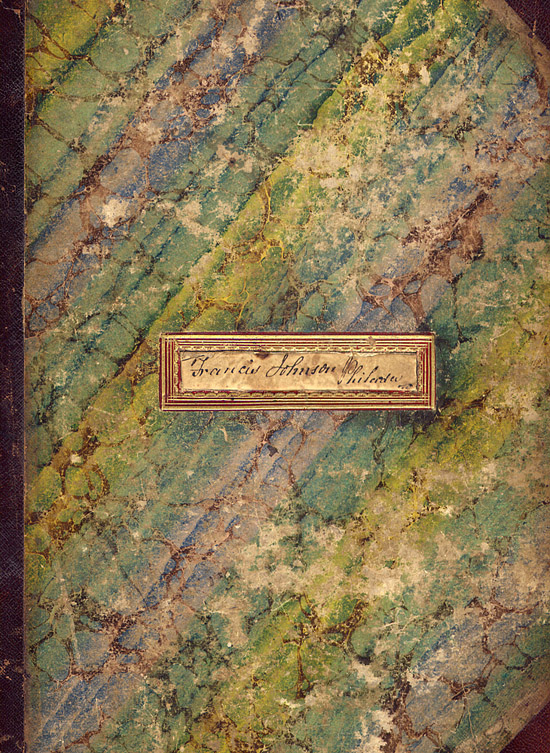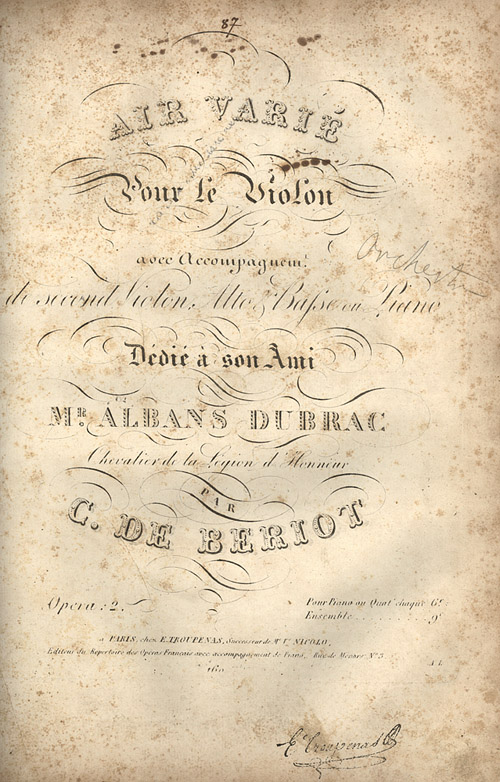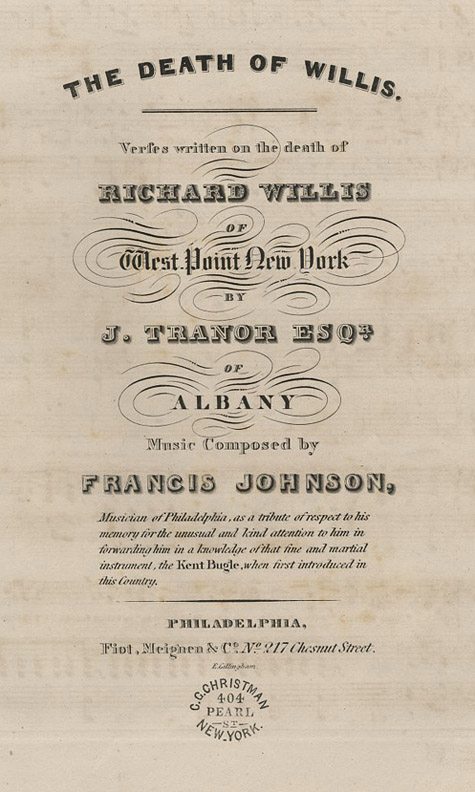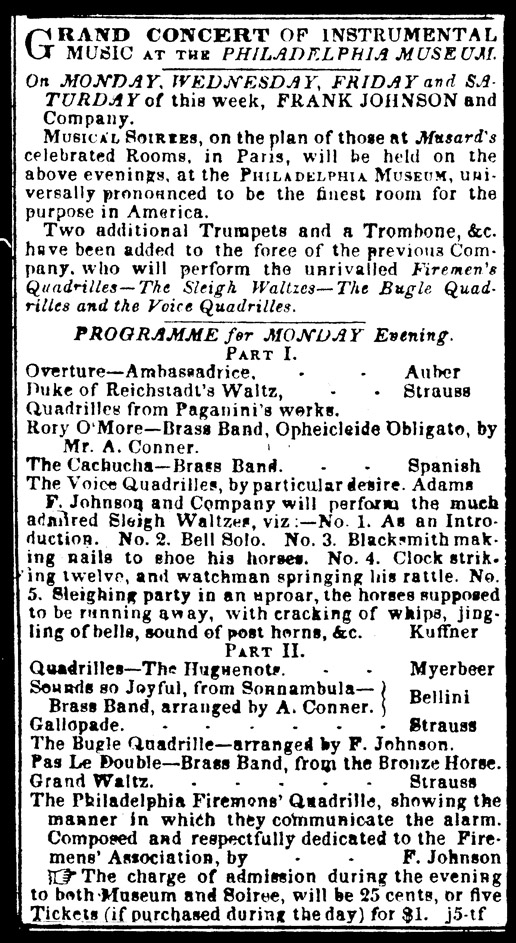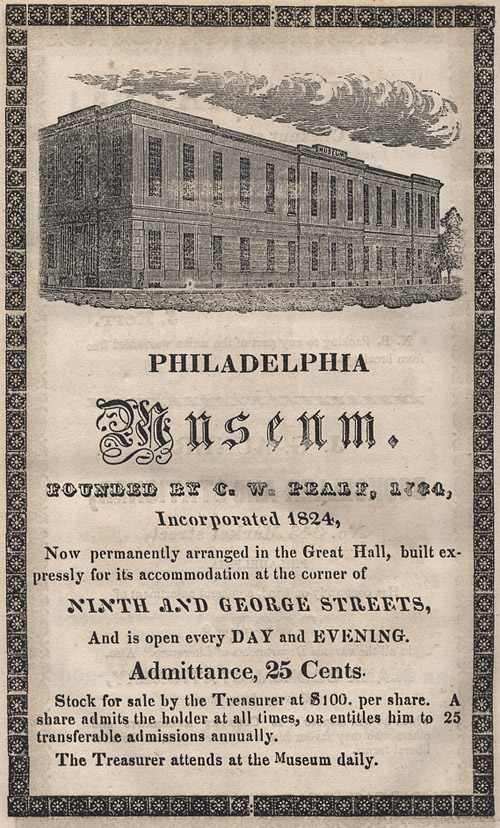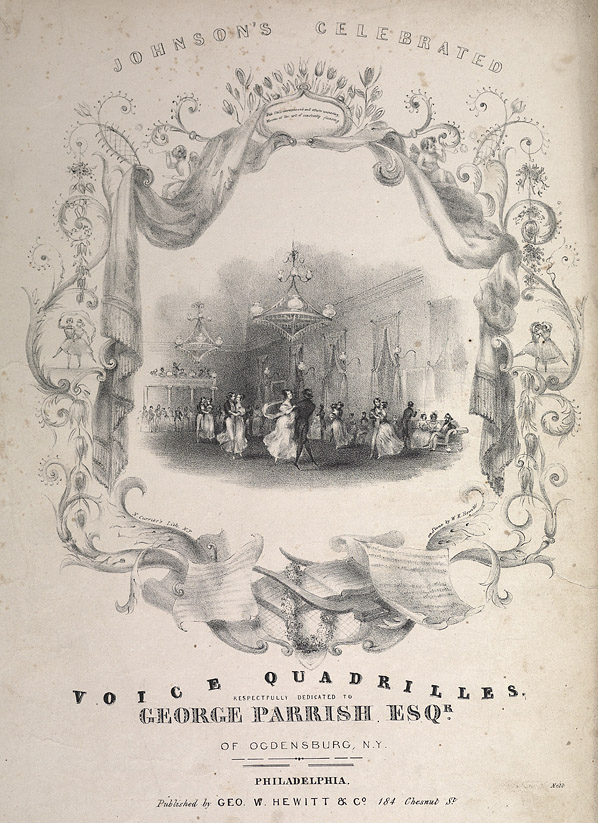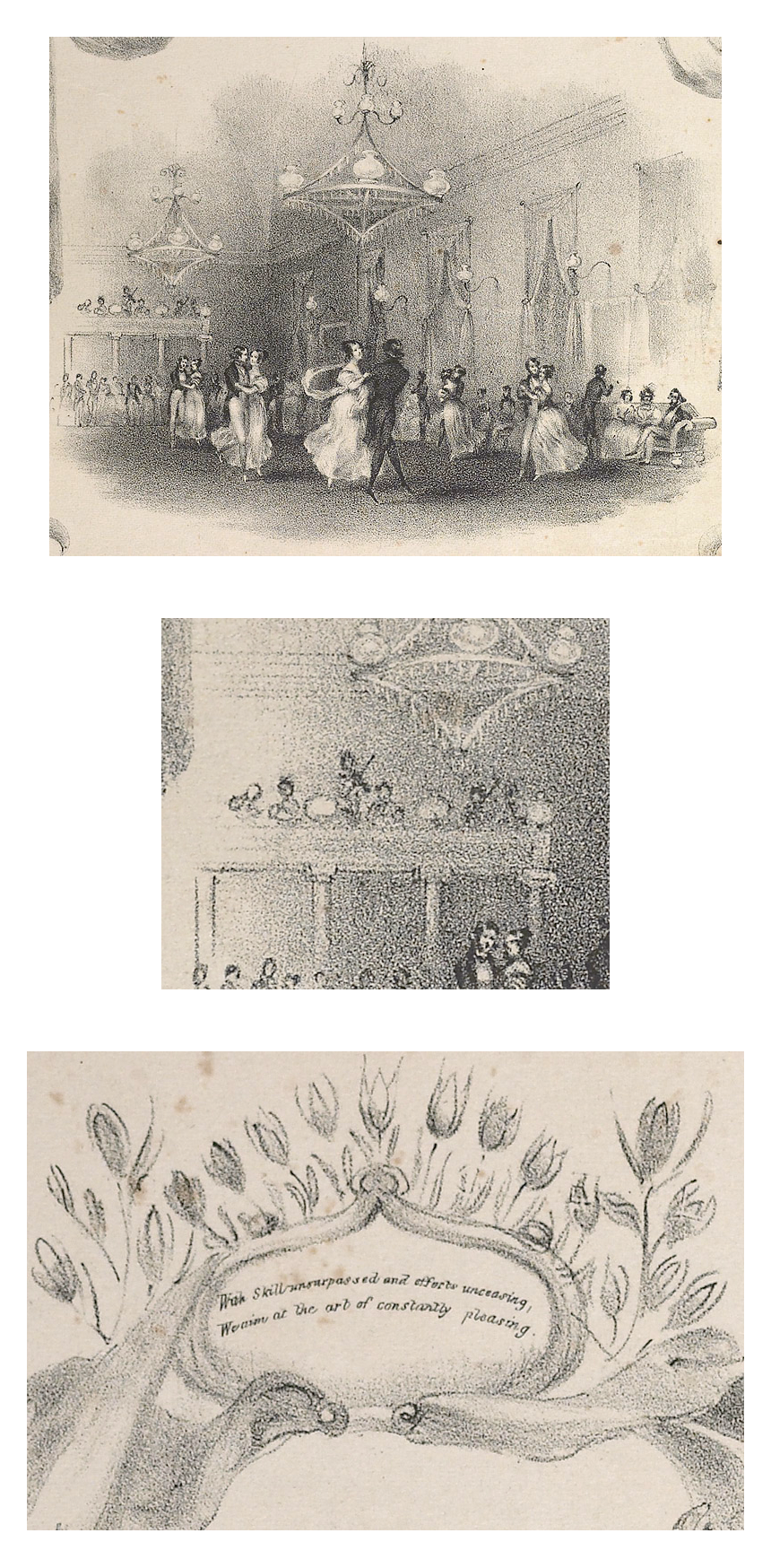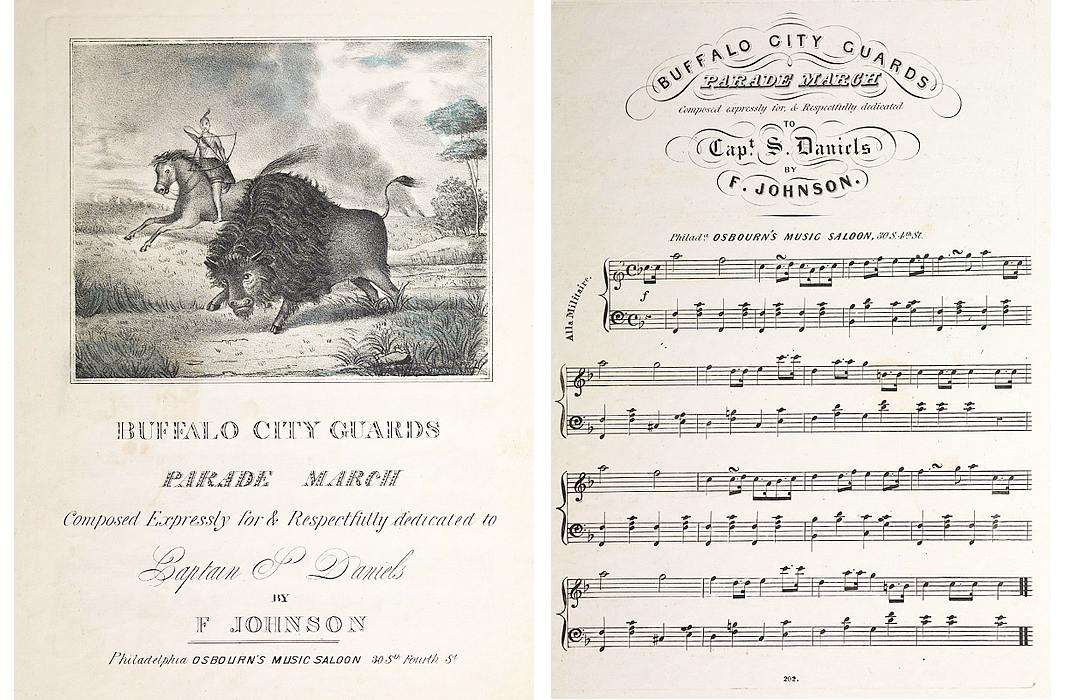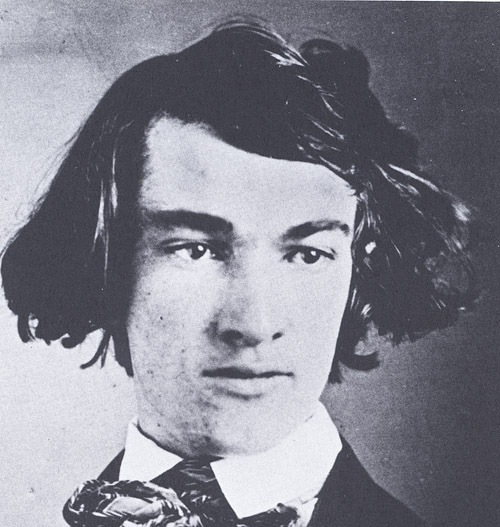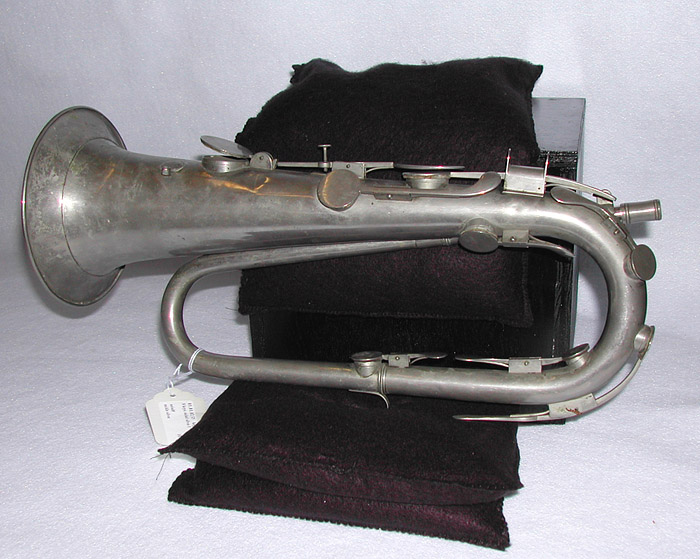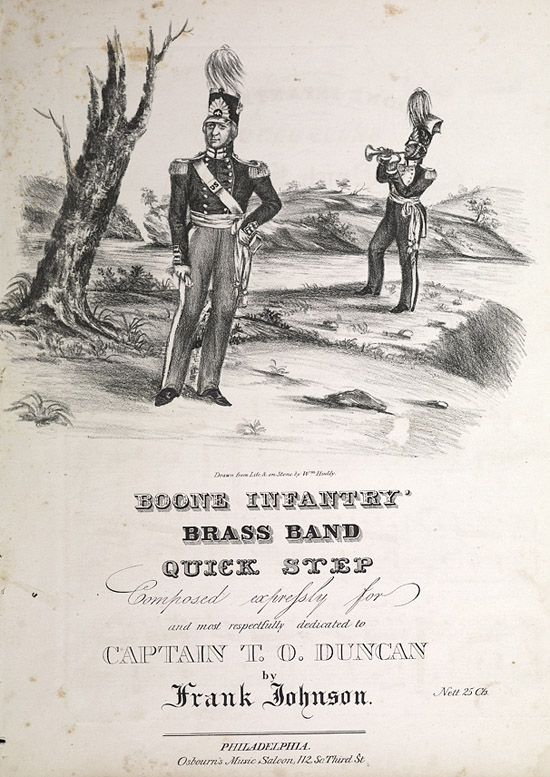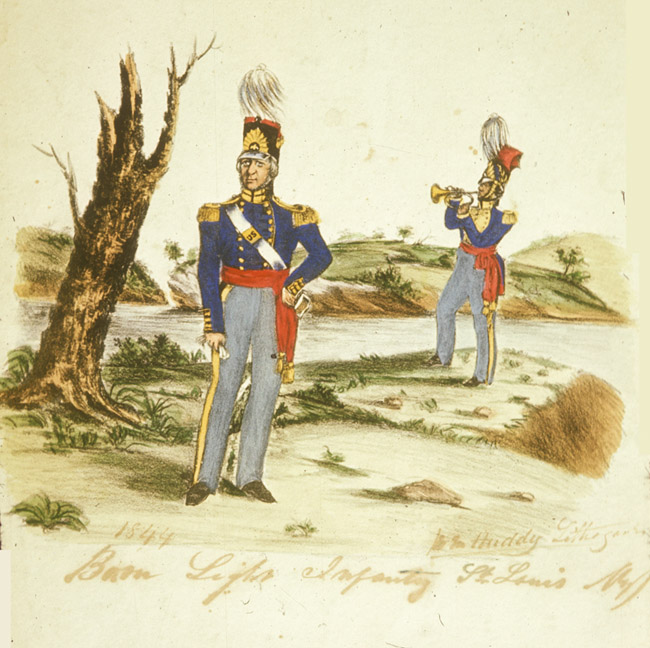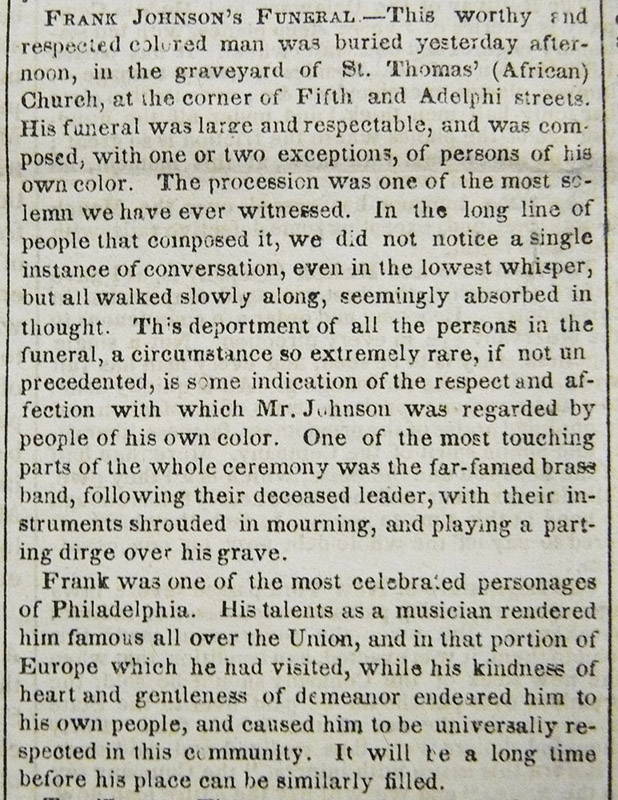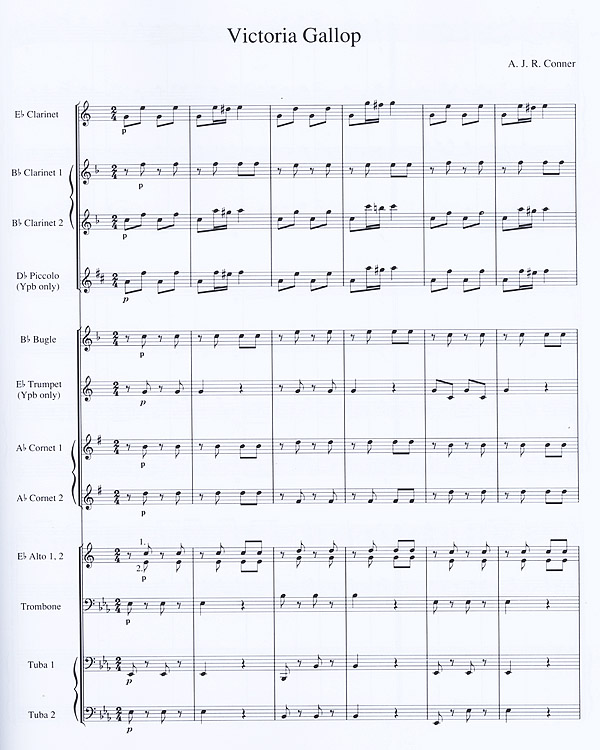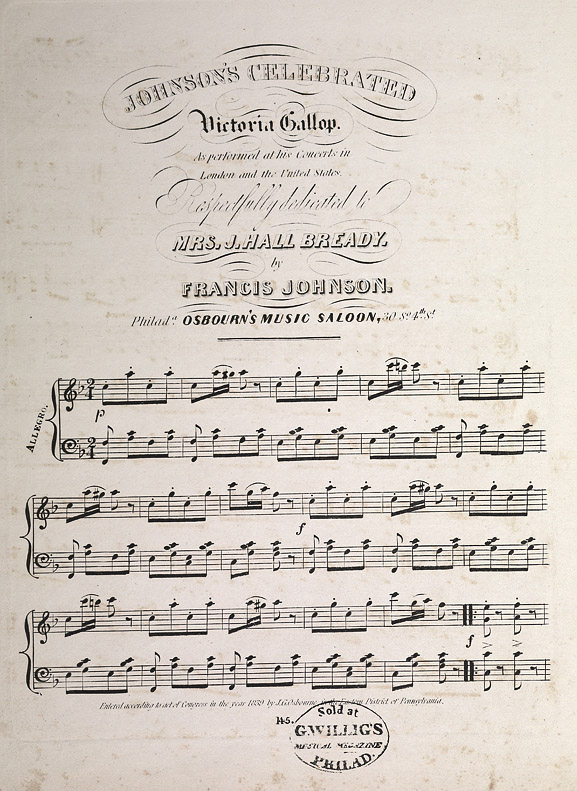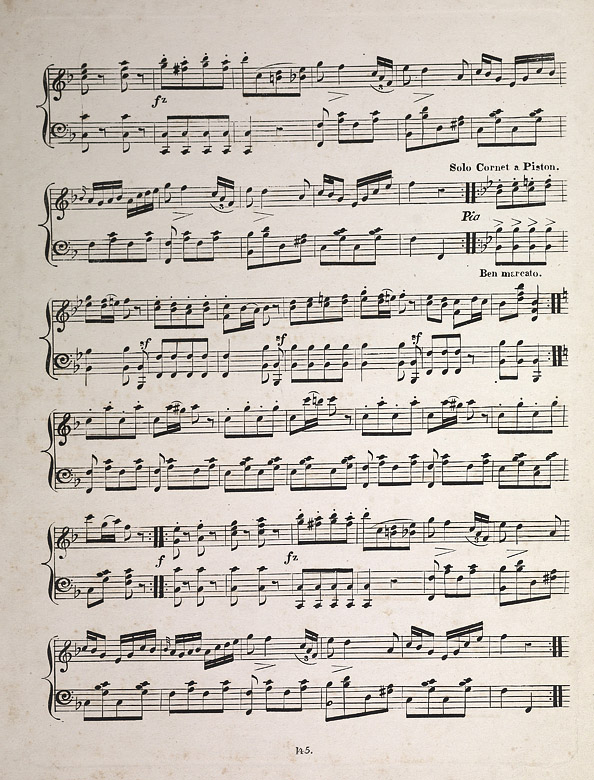Francis Johnson
About Francis Johnson
About Francis Johnson
About Francis Johnson
Performances for Philadelphia's Elite
Performances for Philadelphia's Elite
Performances for Philadelphia's Elite
Performances for the Militia Units
Performances for the Militia Units
Performances for the Militia Units
Orphan's Asylum; Buffalo City Guards
Orphan's Asylum; Buffalo City Guards
Orphan's Asylum; Buffalo City Guards
Summers in Saratoga
Summers in Saratoga
Summers in Saratoga
Trip to England; Concerts in Philadelphia
Trip to England; Concerts in Philadelphia
Trip to England; Concerts in Philadelphia
Johnson's Instruments and Music
Johnson's Instruments and Music
Johnson's Instruments and Music
Johnson as an African American
Johnson as an African American
Johnson as an African American

Introduction
This web exhibit is based on an exhibit that was on display in the Eugene Ormandy Gallery, 4th floor, Van Pelt Library, from fall 2007 through fall 2009. The exhibit was launched with a lecture on Johnson presented by Guthrie P. Ramsey Jr., associate professor of music at Penn, on 10 April 2008. You may listen to the lecture on theScholarlyCommons@Penn site.
Johnson's music survives today in piano arrangements published during his lifetime, and in the exhibit, the Otto E. Albrecht Music Library offered a selection from the over forty pieces of Johnson sheet music acquired in 2007 from the estate of the late Kurt Stein. To allow the viewer of the web exhibit to experience the sound of these piano arrangements, we have included sound files of performances by pianist Tim Ribchester.
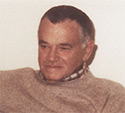
At left: Kurt Stein (1918-2002), reproduced from a family photograph.
The Austrian-born collector assembled forty-two rare early editions of the music of Frank Johnson and a comprehensive collection of books and articles about him. The University of Pennsylvania Libraries acquired the collection in 2006, funded in part by the Alfred Reginald Allen Memorial Fund of the Savoy Company. Unless otherwise noted, the printed music on display is by Frank Johnson and was a part of the collection of Kurt Stein.
Francis ("Frank") Johnson (1792-1844) was a Philadelphia musician, bandleader, and composer. Little is known of his musical training, but by his mid-twenties he had become an accomplished violinist and cornetist and led a dance band that was a favorite among the elite of Philadelphia. His talents eventually were renowned far beyond his hometown through tours of England and the American Midwest during the late 1830s and early 1840s.
Johnson was also an African American, and although a free man, he lived in pre-Civil War America, a time when-even in free states-societal racism imposed limits on the activities of African Americans. His accomplishments were ambitious and remarkable given the overt and sometimes hostile racism he faced, particularly when touring outside Philadelphia in areas where he was not known.
His music-making centered on two traditions of Philadelphia high society: evening entertainment, including balls and dances, for which Johnson's string and brass bands provided cotillions, waltzes, and quadrilles suitable for dancing and socializing; and assemblies and processions of regional militia, for which Johnson's brass band played marches and quicksteps.
Johnson was born on 16 June 1792 in Philadelphia to unknown parents. By the time of his birth, a thriving community of free African Americans had been established in Philadelphia. Although he spent his summers performing in the resort hotels of Saratoga Springs and made occasional regional excursions with his bands, Philadelphia remained his home throughout his life. He died in Philadelphia on 6 April 1844 at the age of 52 after an extended illness. Following his death, Johnson's band continued performing under the direction of bandmember Joseph Anderson. The band eventually dissolved during the years of the Civil War.
Fig. 1: Johnson is listed on the third line from the bottom, with 16 June 1792 as his date of birth and 23 September 1792 as his date of baptism.
Fig. 2: The directory lists "Francis Johnson, musician," residing at 154 Pine Street (since renumbered 536 Pine Street). The city directory listed Johnson at this address as early as 1823, so it served as his home for most of his adult life. In 1992, on the occasional of the bicentennial of his birth, the Pennsylvania Historical and Museum Commission placed a historical marker at the address, commemorating the site as the home of "America's first native-born master of music."
Fig. 3: Very few verifiable portraits of Johnson exist. This lithograph of Johnson in his prime is the one most frequently reproduced. Robert Douglass Jr., a Johnson family friend, was a pioneering African-American artist who studied with Thomas Sully and in England. In 1841, he opened a studio at the corner of Arch and Front Streets for daguerreotyping and sign-painting.
Fig. 4: With the appearance of this first set of cotillions in 1818, Johnson became the first published African American composer. Over two hundred fifty of his compositions were published during succeeding decades, and copies for most of these have survived.
Reproduction of "Johnson's Jig Cotillion" from A Collection of New Cotillins [sic], 1st Sett. Directions for dancers are commonly found in the printed editions of Johnson's music intended to accompany dancing.
Francis ("Frank") Johnson (1792-1844) was a Philadelphia musician, bandleader, and composer. Little is known of his musical training, but by his mid-twenties he had become an accomplished violinist and cornetist and led a dance band that was a favorite among the elite of Philadelphia. His talents eventually were renowned far beyond his hometown through tours of England and the American Midwest during the late 1830s and early 1840s.
Johnson was also an African American, and although a free man, he lived in pre-Civil War America, a time when-even in free states-societal racism imposed limits on the activities of African Americans. His accomplishments were ambitious and remarkable given the overt and sometimes hostile racism he faced, particularly when touring outside Philadelphia in areas where he was not known.
His music-making centered on two traditions of Philadelphia high society: evening entertainment, including balls and dances, for which Johnson's string and brass bands provided cotillions, waltzes, and quadrilles suitable for dancing and socializing; and assemblies and processions of regional militia, for which Johnson's brass band played marches and quicksteps.
Johnson was born on 16 June 1792 in Philadelphia to unknown parents. By the time of his birth, a thriving community of free African Americans had been established in Philadelphia. Although he spent his summers performing in the resort hotels of Saratoga Springs and made occasional regional excursions with his bands, Philadelphia remained his home throughout his life. He died in Philadelphia on 6 April 1844 at the age of 52 after an extended illness. Following his death, Johnson's band continued performing under the direction of bandmember Joseph Anderson. The band eventually dissolved during the years of the Civil War.
Fig. 1: Johnson is listed on the third line from the bottom, with 16 June 1792 as his date of birth and 23 September 1792 as his date of baptism.
Fig. 2: The directory lists "Francis Johnson, musician," residing at 154 Pine Street (since renumbered 536 Pine Street). The city directory listed Johnson at this address as early as 1823, so it served as his home for most of his adult life. In 1992, on the occasional of the bicentennial of his birth, the Pennsylvania Historical and Museum Commission placed a historical marker at the address, commemorating the site as the home of "America's first native-born master of music."
Fig. 3: Very few verifiable portraits of Johnson exist. This lithograph of Johnson in his prime is the one most frequently reproduced. Robert Douglass Jr., a Johnson family friend, was a pioneering African-American artist who studied with Thomas Sully and in England. In 1841, he opened a studio at the corner of Arch and Front Streets for daguerreotyping and sign-painting.
Fig. 4: With the appearance of this first set of cotillions in 1818, Johnson became the first published African American composer. Over two hundred fifty of his compositions were published during succeeding decades, and copies for most of these have survived.
Reproduction of "Johnson's Jig Cotillion" from A Collection of New Cotillins [sic], 1st Sett. Directions for dancers are commonly found in the printed editions of Johnson's music intended to accompany dancing.
Francis ("Frank") Johnson (1792-1844) was a Philadelphia musician, bandleader, and composer. Little is known of his musical training, but by his mid-twenties he had become an accomplished violinist and cornetist and led a dance band that was a favorite among the elite of Philadelphia. His talents eventually were renowned far beyond his hometown through tours of England and the American Midwest during the late 1830s and early 1840s.
Johnson was also an African American, and although a free man, he lived in pre-Civil War America, a time when-even in free states-societal racism imposed limits on the activities of African Americans. His accomplishments were ambitious and remarkable given the overt and sometimes hostile racism he faced, particularly when touring outside Philadelphia in areas where he was not known.
His music-making centered on two traditions of Philadelphia high society: evening entertainment, including balls and dances, for which Johnson's string and brass bands provided cotillions, waltzes, and quadrilles suitable for dancing and socializing; and assemblies and processions of regional militia, for which Johnson's brass band played marches and quicksteps.
Johnson was born on 16 June 1792 in Philadelphia to unknown parents. By the time of his birth, a thriving community of free African Americans had been established in Philadelphia. Although he spent his summers performing in the resort hotels of Saratoga Springs and made occasional regional excursions with his bands, Philadelphia remained his home throughout his life. He died in Philadelphia on 6 April 1844 at the age of 52 after an extended illness. Following his death, Johnson's band continued performing under the direction of bandmember Joseph Anderson. The band eventually dissolved during the years of the Civil War.
Fig. 1: Johnson is listed on the third line from the bottom, with 16 June 1792 as his date of birth and 23 September 1792 as his date of baptism.
Fig. 2: The directory lists "Francis Johnson, musician," residing at 154 Pine Street (since renumbered 536 Pine Street). The city directory listed Johnson at this address as early as 1823, so it served as his home for most of his adult life. In 1992, on the occasional of the bicentennial of his birth, the Pennsylvania Historical and Museum Commission placed a historical marker at the address, commemorating the site as the home of "America's first native-born master of music."
Fig. 3: Very few verifiable portraits of Johnson exist. This lithograph of Johnson in his prime is the one most frequently reproduced. Robert Douglass Jr., a Johnson family friend, was a pioneering African-American artist who studied with Thomas Sully and in England. In 1841, he opened a studio at the corner of Arch and Front Streets for daguerreotyping and sign-painting.
Fig. 4: With the appearance of this first set of cotillions in 1818, Johnson became the first published African American composer. Over two hundred fifty of his compositions were published during succeeding decades, and copies for most of these have survived.
Reproduction of "Johnson's Jig Cotillion" from A Collection of New Cotillins [sic], 1st Sett. Directions for dancers are commonly found in the printed editions of Johnson's music intended to accompany dancing.
Francis ("Frank") Johnson (1792-1844) was a Philadelphia musician, bandleader, and composer. Little is known of his musical training, but by his mid-twenties he had become an accomplished violinist and cornetist and led a dance band that was a favorite among the elite of Philadelphia. His talents eventually were renowned far beyond his hometown through tours of England and the American Midwest during the late 1830s and early 1840s.
Johnson was also an African American, and although a free man, he lived in pre-Civil War America, a time when-even in free states-societal racism imposed limits on the activities of African Americans. His accomplishments were ambitious and remarkable given the overt and sometimes hostile racism he faced, particularly when touring outside Philadelphia in areas where he was not known.
His music-making centered on two traditions of Philadelphia high society: evening entertainment, including balls and dances, for which Johnson's string and brass bands provided cotillions, waltzes, and quadrilles suitable for dancing and socializing; and assemblies and processions of regional militia, for which Johnson's brass band played marches and quicksteps.
Johnson was born on 16 June 1792 in Philadelphia to unknown parents. By the time of his birth, a thriving community of free African Americans had been established in Philadelphia. Although he spent his summers performing in the resort hotels of Saratoga Springs and made occasional regional excursions with his bands, Philadelphia remained his home throughout his life. He died in Philadelphia on 6 April 1844 at the age of 52 after an extended illness. Following his death, Johnson's band continued performing under the direction of bandmember Joseph Anderson. The band eventually dissolved during the years of the Civil War.
Fig. 1: Johnson is listed on the third line from the bottom, with 16 June 1792 as his date of birth and 23 September 1792 as his date of baptism.
Fig. 2: The directory lists "Francis Johnson, musician," residing at 154 Pine Street (since renumbered 536 Pine Street). The city directory listed Johnson at this address as early as 1823, so it served as his home for most of his adult life. In 1992, on the occasional of the bicentennial of his birth, the Pennsylvania Historical and Museum Commission placed a historical marker at the address, commemorating the site as the home of "America's first native-born master of music."
Fig. 3: Very few verifiable portraits of Johnson exist. This lithograph of Johnson in his prime is the one most frequently reproduced. Robert Douglass Jr., a Johnson family friend, was a pioneering African-American artist who studied with Thomas Sully and in England. In 1841, he opened a studio at the corner of Arch and Front Streets for daguerreotyping and sign-painting.
Fig. 4: With the appearance of this first set of cotillions in 1818, Johnson became the first published African American composer. Over two hundred fifty of his compositions were published during succeeding decades, and copies for most of these have survived.
Reproduction of "Johnson's Jig Cotillion" from A Collection of New Cotillins [sic], 1st Sett. Directions for dancers are commonly found in the printed editions of Johnson's music intended to accompany dancing.
When he left Philadelphia and ventured west on a tour of the Midwest, Johnson and his African-American band members did not always receive a warm welcome. Local bands were often resentful of the visiting musicians, who took business away from them. The racism toward Johnson and his band was open and often hostile.
Fig. 1: Report of an incident of racism in Allegheny City (now the north side of Pittsburgh), 16 May 1843
Fig. 2: Haiti was founded following a slave revolt in 1791, which overthrew the government of the French colony St. Domingue. During the early nineteenth century, the French attempted to take back the country, but in 1825, the French government officially recognized Haiti's independence. This country of self-governing people of African descent became an inspiration to African Americans.
Fig. 3: Boyer was president of Haiti from 1818 to 1843. Isacc Mickel, in his diary entry, notes that a portrait of Boyer was hanging on the wall of Johnson's study.
When he left Philadelphia and ventured west on a tour of the Midwest, Johnson and his African-American band members did not always receive a warm welcome. Local bands were often resentful of the visiting musicians, who took business away from them. The racism toward Johnson and his band was open and often hostile.
Fig. 1: Report of an incident of racism in Allegheny City (now the north side of Pittsburgh), 16 May 1843
Fig. 2: Haiti was founded following a slave revolt in 1791, which overthrew the government of the French colony St. Domingue. During the early nineteenth century, the French attempted to take back the country, but in 1825, the French government officially recognized Haiti's independence. This country of self-governing people of African descent became an inspiration to African Americans.
Fig. 3: Boyer was president of Haiti from 1818 to 1843. Isacc Mickel, in his diary entry, notes that a portrait of Boyer was hanging on the wall of Johnson's study.
When he left Philadelphia and ventured west on a tour of the Midwest, Johnson and his African-American band members did not always receive a warm welcome. Local bands were often resentful of the visiting musicians, who took business away from them. The racism toward Johnson and his band was open and often hostile.
Fig. 1: Report of an incident of racism in Allegheny City (now the north side of Pittsburgh), 16 May 1843
Fig. 2: Haiti was founded following a slave revolt in 1791, which overthrew the government of the French colony St. Domingue. During the early nineteenth century, the French attempted to take back the country, but in 1825, the French government officially recognized Haiti's independence. This country of self-governing people of African descent became an inspiration to African Americans.
Fig. 3: Boyer was president of Haiti from 1818 to 1843. Isacc Mickel, in his diary entry, notes that a portrait of Boyer was hanging on the wall of Johnson's study.
On Thursday, 24 January 1822, a fire at the Orphan Asylum of Philadelphia reduced the building to ashes. Many fire companies responded but twenty-three orphans did not survive the blaze. A benefit was held at the Walnut Street Theater on the following Monday, 28 January, featuring a play, a farce, and two musicals. It is possible that Johnson's "Orphan's Cotillion" was composed for performance by Johnson's band at the benefit.
Fig. 1: The Fire Association of Philadelphia was a fire insurance company founded in 1817 and incorporated in 1820. The fireplug in the masthead was the official logo of the company. The closing measures (at the top of the second page) include the cry "Fire, fire, fire, fire," which was probably shouted during a performance by members of the band. The descending chromatic passages in the third strain of "The Orphan's Cotillion" represent the cries of the orphans.
Fig. 2: News of the tragedy traveled quickly. This account in a New Hampshire paper appeared eleven days after the fire.
Fig. 3: Four days after the fire, a benefit was held for the Orphan Asylum at the Walnut Street Theater.
Fig. 4: From Geschichte des Waisenhauses in Philadelphia [History of the Orphan Asylum, in Philadelphia] (Philadelphia, 1833). Free Library of Philadelphia.
On Thursday, 24 January 1822, a fire at the Orphan Asylum of Philadelphia reduced the building to ashes. Many fire companies responded but twenty-three orphans did not survive the blaze. A benefit was held at the Walnut Street Theater on the following Monday, 28 January, featuring a play, a farce, and two musicals. It is possible that Johnson's "Orphan's Cotillion" was composed for performance by Johnson's band at the benefit.
Fig. 1: The Fire Association of Philadelphia was a fire insurance company founded in 1817 and incorporated in 1820. The fireplug in the masthead was the official logo of the company. The closing measures (at the top of the second page) include the cry "Fire, fire, fire, fire," which was probably shouted during a performance by members of the band. The descending chromatic passages in the third strain of "The Orphan's Cotillion" represent the cries of the orphans.
Fig. 2: News of the tragedy traveled quickly. This account in a New Hampshire paper appeared eleven days after the fire.
Fig. 3: Four days after the fire, a benefit was held for the Orphan Asylum at the Walnut Street Theater.
Fig. 4: From Geschichte des Waisenhauses in Philadelphia [History of the Orphan Asylum, in Philadelphia] (Philadelphia, 1833). Free Library of Philadelphia.
On Thursday, 24 January 1822, a fire at the Orphan Asylum of Philadelphia reduced the building to ashes. Many fire companies responded but twenty-three orphans did not survive the blaze. A benefit was held at the Walnut Street Theater on the following Monday, 28 January, featuring a play, a farce, and two musicals. It is possible that Johnson's "Orphan's Cotillion" was composed for performance by Johnson's band at the benefit.
Fig. 1: The Fire Association of Philadelphia was a fire insurance company founded in 1817 and incorporated in 1820. The fireplug in the masthead was the official logo of the company. The closing measures (at the top of the second page) include the cry "Fire, fire, fire, fire," which was probably shouted during a performance by members of the band. The descending chromatic passages in the third strain of "The Orphan's Cotillion" represent the cries of the orphans.
Fig. 2: News of the tragedy traveled quickly. This account in a New Hampshire paper appeared eleven days after the fire.
Fig. 3: Four days after the fire, a benefit was held for the Orphan Asylum at the Walnut Street Theater.
Fig. 4: From Geschichte des Waisenhauses in Philadelphia [History of the Orphan Asylum, in Philadelphia] (Philadelphia, 1833). Free Library of Philadelphia.
On Thursday, 24 January 1822, a fire at the Orphan Asylum of Philadelphia reduced the building to ashes. Many fire companies responded but twenty-three orphans did not survive the blaze. A benefit was held at the Walnut Street Theater on the following Monday, 28 January, featuring a play, a farce, and two musicals. It is possible that Johnson's "Orphan's Cotillion" was composed for performance by Johnson's band at the benefit.
Fig. 1: The Fire Association of Philadelphia was a fire insurance company founded in 1817 and incorporated in 1820. The fireplug in the masthead was the official logo of the company. The closing measures (at the top of the second page) include the cry "Fire, fire, fire, fire," which was probably shouted during a performance by members of the band. The descending chromatic passages in the third strain of "The Orphan's Cotillion" represent the cries of the orphans.
Fig. 2: News of the tragedy traveled quickly. This account in a New Hampshire paper appeared eleven days after the fire.
Fig. 3: Four days after the fire, a benefit was held for the Orphan Asylum at the Walnut Street Theater.
Fig. 4: From Geschichte des Waisenhauses in Philadelphia [History of the Orphan Asylum, in Philadelphia] (Philadelphia, 1833). Free Library of Philadelphia.
Early in his career, Johnson entered into nonexclusive contracts with several militia groups in the Philadelphia area, including the Third Company of Washington Guards, the State Fencibles, and the Washington Grays. These militia groups were organized as a means of defense, but since they were rarely engaged in combat, their assemblies became opportunities for men of high society to gather and socialize. The groups scheduled marches and excursions to visit other regional militia and enlisted the services of Johnson's brass band to provide an air of distinction to their assemblies.
To sweeten his association with these militia organizations, Johnson would compose a march in honor of each group and dedicate it to the commander. Johnson was active in these militia groups until 1838, after his trip to London, at which point he focused on performing concerts and accompanying dances.
Fig. 1: "After the war of 1812 the third company of Washington Guards established a military band composed of colored men. The leader was Frank Johnson. This was substantially a reed band, with clarionets [sic], flutes, one or two bassoons, a serpent, cymbals, triangle, bells, one or two French horns, and bugles, to give force and weight to the air, and a bass drum. There were a tenor drummer and a fifer who never played with the band, but filled up the intervals of the march while the other musicians were resting." (Scharf & Westcott, History of Philadelphia, 1884). According to the minutes of the Third Company, Johnson had been engaged as a bandleader by December 1814.
Fig. 2: Watmough joined the Washington Guards in 1813 and led the unit until 1823. Johnson was apparently popular with Watmough; he hired Johnson to perform at the reception following his wedding to Ellen Coxe on 16 May 1820. Later in his life, Watmough served in the U.S. House of Representatives (1831-35) representing Pennsylvania.
Fig. 5: Cadwalader was elected captain of the Grays in 1832, and Johnson's brass band performed for a number of assemblies, parades, and excursions under his command.
Fig. 6: In February 1832, Johnson's band traveled with the Light Artillery Corps Washingon Grays, under the command of Cadwalader's predecessor, Capt. Joseph Worrell, on an excursion to Mt. Vernon, Virginia, and Washington, D.C.
Fig. 7: Johnson's band was first hired by Capt. James Page in September 1821 to accompany gatherings of the State Fencibles.
"After the third company [of Washington Guards] was disbanded, Johnson's band was employed by other companes [sic]. It was for many years constant in attendance upon parades of the State Fencibles, Capt. James Page. This band was also supplied with stringed instruments, added in service for balls and dancing parties." (Scharf & Westcott, History of Philadelphia, 1884)
Fig. 8: Page joined the State Fencibles in 1814 and was elected captain of the company in 1819. He remained in the post until 1861-a period of forty-two years. He also held a number of political appointments: he was elected a member of the Common Council in 1827, and from 1833 to 1841 he served as postmaster of Philadelphia.
Fig. 9: Johnson's band made a few long excursions with militia groups. In 1828, they joined the State Fencibles on a trip to New York City. In June 1832, a few months after the excursion to Mt. Vernon and Washington D.C. with the Washington Grays, the band traveled with the State Fencibles on a long trip to Boston by way of Newark, Paterson, Easton, New York, Providence, Roxbury, and Salem. Before retiring from militia commitments in 1838, Johnson made a few regional excursions - for example, to New Brunswick, New Jersey (1834), and Albany, New York (1837).
Early in his career, Johnson entered into nonexclusive contracts with several militia groups in the Philadelphia area, including the Third Company of Washington Guards, the State Fencibles, and the Washington Grays. These militia groups were organized as a means of defense, but since they were rarely engaged in combat, their assemblies became opportunities for men of high society to gather and socialize. The groups scheduled marches and excursions to visit other regional militia and enlisted the services of Johnson's brass band to provide an air of distinction to their assemblies.
To sweeten his association with these militia organizations, Johnson would compose a march in honor of each group and dedicate it to the commander. Johnson was active in these militia groups until 1838, after his trip to London, at which point he focused on performing concerts and accompanying dances.
Fig. 1: "After the war of 1812 the third company of Washington Guards established a military band composed of colored men. The leader was Frank Johnson. This was substantially a reed band, with clarionets [sic], flutes, one or two bassoons, a serpent, cymbals, triangle, bells, one or two French horns, and bugles, to give force and weight to the air, and a bass drum. There were a tenor drummer and a fifer who never played with the band, but filled up the intervals of the march while the other musicians were resting." (Scharf & Westcott, History of Philadelphia, 1884). According to the minutes of the Third Company, Johnson had been engaged as a bandleader by December 1814.
Fig. 2: Watmough joined the Washington Guards in 1813 and led the unit until 1823. Johnson was apparently popular with Watmough; he hired Johnson to perform at the reception following his wedding to Ellen Coxe on 16 May 1820. Later in his life, Watmough served in the U.S. House of Representatives (1831-35) representing Pennsylvania.
Fig. 5: Cadwalader was elected captain of the Grays in 1832, and Johnson's brass band performed for a number of assemblies, parades, and excursions under his command.
Fig. 6: In February 1832, Johnson's band traveled with the Light Artillery Corps Washingon Grays, under the command of Cadwalader's predecessor, Capt. Joseph Worrell, on an excursion to Mt. Vernon, Virginia, and Washington, D.C.
Fig. 7: Johnson's band was first hired by Capt. James Page in September 1821 to accompany gatherings of the State Fencibles.
"After the third company [of Washington Guards] was disbanded, Johnson's band was employed by other companes [sic]. It was for many years constant in attendance upon parades of the State Fencibles, Capt. James Page. This band was also supplied with stringed instruments, added in service for balls and dancing parties." (Scharf & Westcott, History of Philadelphia, 1884)
Fig. 8: Page joined the State Fencibles in 1814 and was elected captain of the company in 1819. He remained in the post until 1861-a period of forty-two years. He also held a number of political appointments: he was elected a member of the Common Council in 1827, and from 1833 to 1841 he served as postmaster of Philadelphia.
Fig. 9: Johnson's band made a few long excursions with militia groups. In 1828, they joined the State Fencibles on a trip to New York City. In June 1832, a few months after the excursion to Mt. Vernon and Washington D.C. with the Washington Grays, the band traveled with the State Fencibles on a long trip to Boston by way of Newark, Paterson, Easton, New York, Providence, Roxbury, and Salem. Before retiring from militia commitments in 1838, Johnson made a few regional excursions - for example, to New Brunswick, New Jersey (1834), and Albany, New York (1837).
Early in his career, Johnson entered into nonexclusive contracts with several militia groups in the Philadelphia area, including the Third Company of Washington Guards, the State Fencibles, and the Washington Grays. These militia groups were organized as a means of defense, but since they were rarely engaged in combat, their assemblies became opportunities for men of high society to gather and socialize. The groups scheduled marches and excursions to visit other regional militia and enlisted the services of Johnson's brass band to provide an air of distinction to their assemblies.
To sweeten his association with these militia organizations, Johnson would compose a march in honor of each group and dedicate it to the commander. Johnson was active in these militia groups until 1838, after his trip to London, at which point he focused on performing concerts and accompanying dances.
Fig. 1: "After the war of 1812 the third company of Washington Guards established a military band composed of colored men. The leader was Frank Johnson. This was substantially a reed band, with clarionets [sic], flutes, one or two bassoons, a serpent, cymbals, triangle, bells, one or two French horns, and bugles, to give force and weight to the air, and a bass drum. There were a tenor drummer and a fifer who never played with the band, but filled up the intervals of the march while the other musicians were resting." (Scharf & Westcott, History of Philadelphia, 1884). According to the minutes of the Third Company, Johnson had been engaged as a bandleader by December 1814.
Fig. 2: Watmough joined the Washington Guards in 1813 and led the unit until 1823. Johnson was apparently popular with Watmough; he hired Johnson to perform at the reception following his wedding to Ellen Coxe on 16 May 1820. Later in his life, Watmough served in the U.S. House of Representatives (1831-35) representing Pennsylvania.
Fig. 5: Cadwalader was elected captain of the Grays in 1832, and Johnson's brass band performed for a number of assemblies, parades, and excursions under his command.
Fig. 6: In February 1832, Johnson's band traveled with the Light Artillery Corps Washingon Grays, under the command of Cadwalader's predecessor, Capt. Joseph Worrell, on an excursion to Mt. Vernon, Virginia, and Washington, D.C.
Fig. 7: Johnson's band was first hired by Capt. James Page in September 1821 to accompany gatherings of the State Fencibles.
"After the third company [of Washington Guards] was disbanded, Johnson's band was employed by other companes [sic]. It was for many years constant in attendance upon parades of the State Fencibles, Capt. James Page. This band was also supplied with stringed instruments, added in service for balls and dancing parties." (Scharf & Westcott, History of Philadelphia, 1884)
Fig. 8: Page joined the State Fencibles in 1814 and was elected captain of the company in 1819. He remained in the post until 1861-a period of forty-two years. He also held a number of political appointments: he was elected a member of the Common Council in 1827, and from 1833 to 1841 he served as postmaster of Philadelphia.
Fig. 9: Johnson's band made a few long excursions with militia groups. In 1828, they joined the State Fencibles on a trip to New York City. In June 1832, a few months after the excursion to Mt. Vernon and Washington D.C. with the Washington Grays, the band traveled with the State Fencibles on a long trip to Boston by way of Newark, Paterson, Easton, New York, Providence, Roxbury, and Salem. Before retiring from militia commitments in 1838, Johnson made a few regional excursions - for example, to New Brunswick, New Jersey (1834), and Albany, New York (1837).
Early in his career, Johnson entered into nonexclusive contracts with several militia groups in the Philadelphia area, including the Third Company of Washington Guards, the State Fencibles, and the Washington Grays. These militia groups were organized as a means of defense, but since they were rarely engaged in combat, their assemblies became opportunities for men of high society to gather and socialize. The groups scheduled marches and excursions to visit other regional militia and enlisted the services of Johnson's brass band to provide an air of distinction to their assemblies.
To sweeten his association with these militia organizations, Johnson would compose a march in honor of each group and dedicate it to the commander. Johnson was active in these militia groups until 1838, after his trip to London, at which point he focused on performing concerts and accompanying dances.
Fig. 1: "After the war of 1812 the third company of Washington Guards established a military band composed of colored men. The leader was Frank Johnson. This was substantially a reed band, with clarionets [sic], flutes, one or two bassoons, a serpent, cymbals, triangle, bells, one or two French horns, and bugles, to give force and weight to the air, and a bass drum. There were a tenor drummer and a fifer who never played with the band, but filled up the intervals of the march while the other musicians were resting." (Scharf & Westcott, History of Philadelphia, 1884). According to the minutes of the Third Company, Johnson had been engaged as a bandleader by December 1814.
Fig. 2: Watmough joined the Washington Guards in 1813 and led the unit until 1823. Johnson was apparently popular with Watmough; he hired Johnson to perform at the reception following his wedding to Ellen Coxe on 16 May 1820. Later in his life, Watmough served in the U.S. House of Representatives (1831-35) representing Pennsylvania.
Fig. 5: Cadwalader was elected captain of the Grays in 1832, and Johnson's brass band performed for a number of assemblies, parades, and excursions under his command.
Fig. 6: In February 1832, Johnson's band traveled with the Light Artillery Corps Washingon Grays, under the command of Cadwalader's predecessor, Capt. Joseph Worrell, on an excursion to Mt. Vernon, Virginia, and Washington, D.C.
Fig. 7: Johnson's band was first hired by Capt. James Page in September 1821 to accompany gatherings of the State Fencibles.
"After the third company [of Washington Guards] was disbanded, Johnson's band was employed by other companes [sic]. It was for many years constant in attendance upon parades of the State Fencibles, Capt. James Page. This band was also supplied with stringed instruments, added in service for balls and dancing parties." (Scharf & Westcott, History of Philadelphia, 1884)
Fig. 8: Page joined the State Fencibles in 1814 and was elected captain of the company in 1819. He remained in the post until 1861-a period of forty-two years. He also held a number of political appointments: he was elected a member of the Common Council in 1827, and from 1833 to 1841 he served as postmaster of Philadelphia.
Fig. 9: Johnson's band made a few long excursions with militia groups. In 1828, they joined the State Fencibles on a trip to New York City. In June 1832, a few months after the excursion to Mt. Vernon and Washington D.C. with the Washington Grays, the band traveled with the State Fencibles on a long trip to Boston by way of Newark, Paterson, Easton, New York, Providence, Roxbury, and Salem. Before retiring from militia commitments in 1838, Johnson made a few regional excursions - for example, to New Brunswick, New Jersey (1834), and Albany, New York (1837).
Early in his career, Johnson entered into nonexclusive contracts with several militia groups in the Philadelphia area, including the Third Company of Washington Guards, the State Fencibles, and the Washington Grays. These militia groups were organized as a means of defense, but since they were rarely engaged in combat, their assemblies became opportunities for men of high society to gather and socialize. The groups scheduled marches and excursions to visit other regional militia and enlisted the services of Johnson's brass band to provide an air of distinction to their assemblies.
To sweeten his association with these militia organizations, Johnson would compose a march in honor of each group and dedicate it to the commander. Johnson was active in these militia groups until 1838, after his trip to London, at which point he focused on performing concerts and accompanying dances.
Fig. 1: "After the war of 1812 the third company of Washington Guards established a military band composed of colored men. The leader was Frank Johnson. This was substantially a reed band, with clarionets [sic], flutes, one or two bassoons, a serpent, cymbals, triangle, bells, one or two French horns, and bugles, to give force and weight to the air, and a bass drum. There were a tenor drummer and a fifer who never played with the band, but filled up the intervals of the march while the other musicians were resting." (Scharf & Westcott, History of Philadelphia, 1884). According to the minutes of the Third Company, Johnson had been engaged as a bandleader by December 1814.
Fig. 2: Watmough joined the Washington Guards in 1813 and led the unit until 1823. Johnson was apparently popular with Watmough; he hired Johnson to perform at the reception following his wedding to Ellen Coxe on 16 May 1820. Later in his life, Watmough served in the U.S. House of Representatives (1831-35) representing Pennsylvania.
Fig. 5: Cadwalader was elected captain of the Grays in 1832, and Johnson's brass band performed for a number of assemblies, parades, and excursions under his command.
Fig. 6: In February 1832, Johnson's band traveled with the Light Artillery Corps Washingon Grays, under the command of Cadwalader's predecessor, Capt. Joseph Worrell, on an excursion to Mt. Vernon, Virginia, and Washington, D.C.
Fig. 7: Johnson's band was first hired by Capt. James Page in September 1821 to accompany gatherings of the State Fencibles.
"After the third company [of Washington Guards] was disbanded, Johnson's band was employed by other companes [sic]. It was for many years constant in attendance upon parades of the State Fencibles, Capt. James Page. This band was also supplied with stringed instruments, added in service for balls and dancing parties." (Scharf & Westcott, History of Philadelphia, 1884)
Fig. 8: Page joined the State Fencibles in 1814 and was elected captain of the company in 1819. He remained in the post until 1861-a period of forty-two years. He also held a number of political appointments: he was elected a member of the Common Council in 1827, and from 1833 to 1841 he served as postmaster of Philadelphia.
Fig. 9: Johnson's band made a few long excursions with militia groups. In 1828, they joined the State Fencibles on a trip to New York City. In June 1832, a few months after the excursion to Mt. Vernon and Washington D.C. with the Washington Grays, the band traveled with the State Fencibles on a long trip to Boston by way of Newark, Paterson, Easton, New York, Providence, Roxbury, and Salem. Before retiring from militia commitments in 1838, Johnson made a few regional excursions - for example, to New Brunswick, New Jersey (1834), and Albany, New York (1837).
Early in his career, Johnson entered into nonexclusive contracts with several militia groups in the Philadelphia area, including the Third Company of Washington Guards, the State Fencibles, and the Washington Grays. These militia groups were organized as a means of defense, but since they were rarely engaged in combat, their assemblies became opportunities for men of high society to gather and socialize. The groups scheduled marches and excursions to visit other regional militia and enlisted the services of Johnson's brass band to provide an air of distinction to their assemblies.
To sweeten his association with these militia organizations, Johnson would compose a march in honor of each group and dedicate it to the commander. Johnson was active in these militia groups until 1838, after his trip to London, at which point he focused on performing concerts and accompanying dances.
Fig. 1: "After the war of 1812 the third company of Washington Guards established a military band composed of colored men. The leader was Frank Johnson. This was substantially a reed band, with clarionets [sic], flutes, one or two bassoons, a serpent, cymbals, triangle, bells, one or two French horns, and bugles, to give force and weight to the air, and a bass drum. There were a tenor drummer and a fifer who never played with the band, but filled up the intervals of the march while the other musicians were resting." (Scharf & Westcott, History of Philadelphia, 1884). According to the minutes of the Third Company, Johnson had been engaged as a bandleader by December 1814.
Fig. 2: Watmough joined the Washington Guards in 1813 and led the unit until 1823. Johnson was apparently popular with Watmough; he hired Johnson to perform at the reception following his wedding to Ellen Coxe on 16 May 1820. Later in his life, Watmough served in the U.S. House of Representatives (1831-35) representing Pennsylvania.
Fig. 5: Cadwalader was elected captain of the Grays in 1832, and Johnson's brass band performed for a number of assemblies, parades, and excursions under his command.
Fig. 6: In February 1832, Johnson's band traveled with the Light Artillery Corps Washingon Grays, under the command of Cadwalader's predecessor, Capt. Joseph Worrell, on an excursion to Mt. Vernon, Virginia, and Washington, D.C.
Fig. 7: Johnson's band was first hired by Capt. James Page in September 1821 to accompany gatherings of the State Fencibles.
"After the third company [of Washington Guards] was disbanded, Johnson's band was employed by other companes [sic]. It was for many years constant in attendance upon parades of the State Fencibles, Capt. James Page. This band was also supplied with stringed instruments, added in service for balls and dancing parties." (Scharf & Westcott, History of Philadelphia, 1884)
Fig. 8: Page joined the State Fencibles in 1814 and was elected captain of the company in 1819. He remained in the post until 1861-a period of forty-two years. He also held a number of political appointments: he was elected a member of the Common Council in 1827, and from 1833 to 1841 he served as postmaster of Philadelphia.
Fig. 9: Johnson's band made a few long excursions with militia groups. In 1828, they joined the State Fencibles on a trip to New York City. In June 1832, a few months after the excursion to Mt. Vernon and Washington D.C. with the Washington Grays, the band traveled with the State Fencibles on a long trip to Boston by way of Newark, Paterson, Easton, New York, Providence, Roxbury, and Salem. Before retiring from militia commitments in 1838, Johnson made a few regional excursions - for example, to New Brunswick, New Jersey (1834), and Albany, New York (1837).
Early in his career, Johnson entered into nonexclusive contracts with several militia groups in the Philadelphia area, including the Third Company of Washington Guards, the State Fencibles, and the Washington Grays. These militia groups were organized as a means of defense, but since they were rarely engaged in combat, their assemblies became opportunities for men of high society to gather and socialize. The groups scheduled marches and excursions to visit other regional militia and enlisted the services of Johnson's brass band to provide an air of distinction to their assemblies.
To sweeten his association with these militia organizations, Johnson would compose a march in honor of each group and dedicate it to the commander. Johnson was active in these militia groups until 1838, after his trip to London, at which point he focused on performing concerts and accompanying dances.
Fig. 1: "After the war of 1812 the third company of Washington Guards established a military band composed of colored men. The leader was Frank Johnson. This was substantially a reed band, with clarionets [sic], flutes, one or two bassoons, a serpent, cymbals, triangle, bells, one or two French horns, and bugles, to give force and weight to the air, and a bass drum. There were a tenor drummer and a fifer who never played with the band, but filled up the intervals of the march while the other musicians were resting." (Scharf & Westcott, History of Philadelphia, 1884). According to the minutes of the Third Company, Johnson had been engaged as a bandleader by December 1814.
Fig. 2: Watmough joined the Washington Guards in 1813 and led the unit until 1823. Johnson was apparently popular with Watmough; he hired Johnson to perform at the reception following his wedding to Ellen Coxe on 16 May 1820. Later in his life, Watmough served in the U.S. House of Representatives (1831-35) representing Pennsylvania.
Fig. 5: Cadwalader was elected captain of the Grays in 1832, and Johnson's brass band performed for a number of assemblies, parades, and excursions under his command.
Fig. 6: In February 1832, Johnson's band traveled with the Light Artillery Corps Washingon Grays, under the command of Cadwalader's predecessor, Capt. Joseph Worrell, on an excursion to Mt. Vernon, Virginia, and Washington, D.C.
Fig. 7: Johnson's band was first hired by Capt. James Page in September 1821 to accompany gatherings of the State Fencibles.
"After the third company [of Washington Guards] was disbanded, Johnson's band was employed by other companes [sic]. It was for many years constant in attendance upon parades of the State Fencibles, Capt. James Page. This band was also supplied with stringed instruments, added in service for balls and dancing parties." (Scharf & Westcott, History of Philadelphia, 1884)
Fig. 8: Page joined the State Fencibles in 1814 and was elected captain of the company in 1819. He remained in the post until 1861-a period of forty-two years. He also held a number of political appointments: he was elected a member of the Common Council in 1827, and from 1833 to 1841 he served as postmaster of Philadelphia.
Fig. 9: Johnson's band made a few long excursions with militia groups. In 1828, they joined the State Fencibles on a trip to New York City. In June 1832, a few months after the excursion to Mt. Vernon and Washington D.C. with the Washington Grays, the band traveled with the State Fencibles on a long trip to Boston by way of Newark, Paterson, Easton, New York, Providence, Roxbury, and Salem. Before retiring from militia commitments in 1838, Johnson made a few regional excursions - for example, to New Brunswick, New Jersey (1834), and Albany, New York (1837).
Early in his career, Johnson entered into nonexclusive contracts with several militia groups in the Philadelphia area, including the Third Company of Washington Guards, the State Fencibles, and the Washington Grays. These militia groups were organized as a means of defense, but since they were rarely engaged in combat, their assemblies became opportunities for men of high society to gather and socialize. The groups scheduled marches and excursions to visit other regional militia and enlisted the services of Johnson's brass band to provide an air of distinction to their assemblies.
To sweeten his association with these militia organizations, Johnson would compose a march in honor of each group and dedicate it to the commander. Johnson was active in these militia groups until 1838, after his trip to London, at which point he focused on performing concerts and accompanying dances.
Fig. 1: "After the war of 1812 the third company of Washington Guards established a military band composed of colored men. The leader was Frank Johnson. This was substantially a reed band, with clarionets [sic], flutes, one or two bassoons, a serpent, cymbals, triangle, bells, one or two French horns, and bugles, to give force and weight to the air, and a bass drum. There were a tenor drummer and a fifer who never played with the band, but filled up the intervals of the march while the other musicians were resting." (Scharf & Westcott, History of Philadelphia, 1884). According to the minutes of the Third Company, Johnson had been engaged as a bandleader by December 1814.
Fig. 2: Watmough joined the Washington Guards in 1813 and led the unit until 1823. Johnson was apparently popular with Watmough; he hired Johnson to perform at the reception following his wedding to Ellen Coxe on 16 May 1820. Later in his life, Watmough served in the U.S. House of Representatives (1831-35) representing Pennsylvania.
Fig. 5: Cadwalader was elected captain of the Grays in 1832, and Johnson's brass band performed for a number of assemblies, parades, and excursions under his command.
Fig. 6: In February 1832, Johnson's band traveled with the Light Artillery Corps Washingon Grays, under the command of Cadwalader's predecessor, Capt. Joseph Worrell, on an excursion to Mt. Vernon, Virginia, and Washington, D.C.
Fig. 7: Johnson's band was first hired by Capt. James Page in September 1821 to accompany gatherings of the State Fencibles.
"After the third company [of Washington Guards] was disbanded, Johnson's band was employed by other companes [sic]. It was for many years constant in attendance upon parades of the State Fencibles, Capt. James Page. This band was also supplied with stringed instruments, added in service for balls and dancing parties." (Scharf & Westcott, History of Philadelphia, 1884)
Fig. 8: Page joined the State Fencibles in 1814 and was elected captain of the company in 1819. He remained in the post until 1861-a period of forty-two years. He also held a number of political appointments: he was elected a member of the Common Council in 1827, and from 1833 to 1841 he served as postmaster of Philadelphia.
Fig. 9: Johnson's band made a few long excursions with militia groups. In 1828, they joined the State Fencibles on a trip to New York City. In June 1832, a few months after the excursion to Mt. Vernon and Washington D.C. with the Washington Grays, the band traveled with the State Fencibles on a long trip to Boston by way of Newark, Paterson, Easton, New York, Providence, Roxbury, and Salem. Before retiring from militia commitments in 1838, Johnson made a few regional excursions - for example, to New Brunswick, New Jersey (1834), and Albany, New York (1837).
Early in his career, Johnson entered into nonexclusive contracts with several militia groups in the Philadelphia area, including the Third Company of Washington Guards, the State Fencibles, and the Washington Grays. These militia groups were organized as a means of defense, but since they were rarely engaged in combat, their assemblies became opportunities for men of high society to gather and socialize. The groups scheduled marches and excursions to visit other regional militia and enlisted the services of Johnson's brass band to provide an air of distinction to their assemblies.
To sweeten his association with these militia organizations, Johnson would compose a march in honor of each group and dedicate it to the commander. Johnson was active in these militia groups until 1838, after his trip to London, at which point he focused on performing concerts and accompanying dances.
Fig. 1: "After the war of 1812 the third company of Washington Guards established a military band composed of colored men. The leader was Frank Johnson. This was substantially a reed band, with clarionets [sic], flutes, one or two bassoons, a serpent, cymbals, triangle, bells, one or two French horns, and bugles, to give force and weight to the air, and a bass drum. There were a tenor drummer and a fifer who never played with the band, but filled up the intervals of the march while the other musicians were resting." (Scharf & Westcott, History of Philadelphia, 1884). According to the minutes of the Third Company, Johnson had been engaged as a bandleader by December 1814.
Fig. 2: Watmough joined the Washington Guards in 1813 and led the unit until 1823. Johnson was apparently popular with Watmough; he hired Johnson to perform at the reception following his wedding to Ellen Coxe on 16 May 1820. Later in his life, Watmough served in the U.S. House of Representatives (1831-35) representing Pennsylvania.
Fig. 5: Cadwalader was elected captain of the Grays in 1832, and Johnson's brass band performed for a number of assemblies, parades, and excursions under his command.
Fig. 6: In February 1832, Johnson's band traveled with the Light Artillery Corps Washingon Grays, under the command of Cadwalader's predecessor, Capt. Joseph Worrell, on an excursion to Mt. Vernon, Virginia, and Washington, D.C.
Fig. 7: Johnson's band was first hired by Capt. James Page in September 1821 to accompany gatherings of the State Fencibles.
"After the third company [of Washington Guards] was disbanded, Johnson's band was employed by other companes [sic]. It was for many years constant in attendance upon parades of the State Fencibles, Capt. James Page. This band was also supplied with stringed instruments, added in service for balls and dancing parties." (Scharf & Westcott, History of Philadelphia, 1884)
Fig. 8: Page joined the State Fencibles in 1814 and was elected captain of the company in 1819. He remained in the post until 1861-a period of forty-two years. He also held a number of political appointments: he was elected a member of the Common Council in 1827, and from 1833 to 1841 he served as postmaster of Philadelphia.
Fig. 9: Johnson's band made a few long excursions with militia groups. In 1828, they joined the State Fencibles on a trip to New York City. In June 1832, a few months after the excursion to Mt. Vernon and Washington D.C. with the Washington Grays, the band traveled with the State Fencibles on a long trip to Boston by way of Newark, Paterson, Easton, New York, Providence, Roxbury, and Salem. Before retiring from militia commitments in 1838, Johnson made a few regional excursions - for example, to New Brunswick, New Jersey (1834), and Albany, New York (1837).
As an African American musician working within the traditions of white society, Johnson adopted a musical style that suited the tastes of his audience. His dance music was light, simple, and tuneful. It is thought that some of his earliest performances were as a fiddler in Philadelphia coffee houses, but it was not until 1818, when he was 26 years old and had formed a band, that Johnson was first mentioned in the Philadelphia press. His musicianship and affable, courtly manner won him respect and admiration among the elite of Philadelphia society, and he quickly became the mostly popular bandleader in the city.
In Robert Waln's satire of Philadelphia society, The Hermit in America on a Visit to Philadelphia (1819), one Peter Atall, a fictional Philadelphian, describes Johnson's performances at the Masonic Hall to the narrator, "the Hermit of Guiana":
"'You observe the leader of the band. He is a descendant of Africa, and possesses a most respectable share of musical talents. - Among other follies of our young ladies, it is quite a fashionable one, to be 'enchanted' with this fiddler. He is indeed a prominent character in the gay world, and happy the lady, in whose ear at the midnight hour he pours the dulcet notes of love!... This fiddler is the presiding deity on such occasions, and although a tawny one, is not the less fervently invoked on that account. In fine, he is leader of the band at all balls, public and private; sole director of all serenades, acceptable and not acceptable; inventor-general of cotillions; to which add, a remarkable taste in distorting a sentimental, simple, and beautiful song, into a reel, jig, or country-dance; - and you have a pretty correct idea of the favoured little J-ns-n" (From "The Cotillion Party.'" In The Hermit in America on a Visit to Philadelphia. 2nd ed. (Philadelphia, 1819).
Johnson's social musical engagements were not limited to balls and dances, however. His band accompanied musical productions in Philadelphia theaters and provided music for ceremonial events.
Fig. 1: This march was excerpted from the incidental music Johnson composed for Joseph Cowell's 1824 production at the Walnut Street Theatre of W. T. Moncrieff's play, The Cataract of the Ganges; or, The Rajah's Daughter.
Fig. 2: The Walnut Street Theater, the oldest theater still in use in America, opened in 1809 as the New Circus, featuring animal and other circus acts. By 1820, it had become a playhouse and was the site for the 1824 production of The Cataract of the Ganges.
Fig. 3: Johnson's band performed for several events at the University of Pennsylvania. This newspaper account of the 26 March 1842 commencement of Penn School of Medicine, held in the Musical Fund Hall on Locust Street, lists the pieces performed by Johnson's "brass and stringed" bands, which "enlivened the meeting at intervals."
Fig. 4: Johnson was paid twenty dollars for "Music for Exhibition," presumably the performance at the Medical Commencement that had occurred on 26 March 1842. According to the index to the Board of Trustee meeting minutes, Johnson was paid eight times between January 1832 and April 1842 for performances at university events. Johnson's band was also engaged by other area universities for commencement ceremonies - for example, the 30 September 1840 commencement ball at Princeton, for which he composed "The Princeton Grand March."
Fig. 5: These pieces, bearing the dedication "For Mrs. J. Reed," are piano arrangements that were probably prepared by Johnson for performance by Mrs. Reed in her home.
Fig. 6: Phoebe Ann Rush, wife of physician James Benjamin Rush, was well educated and a brilliant conversationalist. Her house in Philadelphia was one of the finest in the country, and her entertainments were large and luxurious.
The 15 February 1828 entry in the diary of Philadelphia socialite Samuel Breck includes an account of a ball at the Rush mansion:
"We attended a ball at Mrs. R. [sic] Rush's in the Doctor's new and well contrived house in Chestnut Street. No house in town is furnished so prettily. The pictures and mirrors are framed with rich gilding, relieved by deep crimson velvet, and the statuary in the niches on the stairway and over the doors are principally of Italian marble and workmanship.... Johnson, with five of his Band, was there. A propos of Johnson: This Black musician is a man of taste, and even science in his vocation. He has organized a large band, and gives lessons upon various instruments; and what is still more useful and certainly more singular is the talent he has of turning every lively tune in the new operas to his purpose by adapting to it a Quadrille or Cotillion of his own composing which he introduces at the parties in Philada. and then gets engraved and circulated thro' the union; thus becoming the author of all novelty in dancing."
As an African American musician working within the traditions of white society, Johnson adopted a musical style that suited the tastes of his audience. His dance music was light, simple, and tuneful. It is thought that some of his earliest performances were as a fiddler in Philadelphia coffee houses, but it was not until 1818, when he was 26 years old and had formed a band, that Johnson was first mentioned in the Philadelphia press. His musicianship and affable, courtly manner won him respect and admiration among the elite of Philadelphia society, and he quickly became the mostly popular bandleader in the city.
In Robert Waln's satire of Philadelphia society, The Hermit in America on a Visit to Philadelphia (1819), one Peter Atall, a fictional Philadelphian, describes Johnson's performances at the Masonic Hall to the narrator, "the Hermit of Guiana":
"'You observe the leader of the band. He is a descendant of Africa, and possesses a most respectable share of musical talents. - Among other follies of our young ladies, it is quite a fashionable one, to be 'enchanted' with this fiddler. He is indeed a prominent character in the gay world, and happy the lady, in whose ear at the midnight hour he pours the dulcet notes of love!... This fiddler is the presiding deity on such occasions, and although a tawny one, is not the less fervently invoked on that account. In fine, he is leader of the band at all balls, public and private; sole director of all serenades, acceptable and not acceptable; inventor-general of cotillions; to which add, a remarkable taste in distorting a sentimental, simple, and beautiful song, into a reel, jig, or country-dance; - and you have a pretty correct idea of the favoured little J-ns-n" (From "The Cotillion Party.'" In The Hermit in America on a Visit to Philadelphia. 2nd ed. (Philadelphia, 1819).
Johnson's social musical engagements were not limited to balls and dances, however. His band accompanied musical productions in Philadelphia theaters and provided music for ceremonial events.
Fig. 1: This march was excerpted from the incidental music Johnson composed for Joseph Cowell's 1824 production at the Walnut Street Theatre of W. T. Moncrieff's play, The Cataract of the Ganges; or, The Rajah's Daughter.
Fig. 2: The Walnut Street Theater, the oldest theater still in use in America, opened in 1809 as the New Circus, featuring animal and other circus acts. By 1820, it had become a playhouse and was the site for the 1824 production of The Cataract of the Ganges.
Fig. 3: Johnson's band performed for several events at the University of Pennsylvania. This newspaper account of the 26 March 1842 commencement of Penn School of Medicine, held in the Musical Fund Hall on Locust Street, lists the pieces performed by Johnson's "brass and stringed" bands, which "enlivened the meeting at intervals."
Fig. 4: Johnson was paid twenty dollars for "Music for Exhibition," presumably the performance at the Medical Commencement that had occurred on 26 March 1842. According to the index to the Board of Trustee meeting minutes, Johnson was paid eight times between January 1832 and April 1842 for performances at university events. Johnson's band was also engaged by other area universities for commencement ceremonies - for example, the 30 September 1840 commencement ball at Princeton, for which he composed "The Princeton Grand March."
Fig. 5: These pieces, bearing the dedication "For Mrs. J. Reed," are piano arrangements that were probably prepared by Johnson for performance by Mrs. Reed in her home.
Fig. 6: Phoebe Ann Rush, wife of physician James Benjamin Rush, was well educated and a brilliant conversationalist. Her house in Philadelphia was one of the finest in the country, and her entertainments were large and luxurious.
The 15 February 1828 entry in the diary of Philadelphia socialite Samuel Breck includes an account of a ball at the Rush mansion:
"We attended a ball at Mrs. R. [sic] Rush's in the Doctor's new and well contrived house in Chestnut Street. No house in town is furnished so prettily. The pictures and mirrors are framed with rich gilding, relieved by deep crimson velvet, and the statuary in the niches on the stairway and over the doors are principally of Italian marble and workmanship.... Johnson, with five of his Band, was there. A propos of Johnson: This Black musician is a man of taste, and even science in his vocation. He has organized a large band, and gives lessons upon various instruments; and what is still more useful and certainly more singular is the talent he has of turning every lively tune in the new operas to his purpose by adapting to it a Quadrille or Cotillion of his own composing which he introduces at the parties in Philada. and then gets engraved and circulated thro' the union; thus becoming the author of all novelty in dancing."
As an African American musician working within the traditions of white society, Johnson adopted a musical style that suited the tastes of his audience. His dance music was light, simple, and tuneful. It is thought that some of his earliest performances were as a fiddler in Philadelphia coffee houses, but it was not until 1818, when he was 26 years old and had formed a band, that Johnson was first mentioned in the Philadelphia press. His musicianship and affable, courtly manner won him respect and admiration among the elite of Philadelphia society, and he quickly became the mostly popular bandleader in the city.
In Robert Waln's satire of Philadelphia society, The Hermit in America on a Visit to Philadelphia (1819), one Peter Atall, a fictional Philadelphian, describes Johnson's performances at the Masonic Hall to the narrator, "the Hermit of Guiana":
"'You observe the leader of the band. He is a descendant of Africa, and possesses a most respectable share of musical talents. - Among other follies of our young ladies, it is quite a fashionable one, to be 'enchanted' with this fiddler. He is indeed a prominent character in the gay world, and happy the lady, in whose ear at the midnight hour he pours the dulcet notes of love!... This fiddler is the presiding deity on such occasions, and although a tawny one, is not the less fervently invoked on that account. In fine, he is leader of the band at all balls, public and private; sole director of all serenades, acceptable and not acceptable; inventor-general of cotillions; to which add, a remarkable taste in distorting a sentimental, simple, and beautiful song, into a reel, jig, or country-dance; - and you have a pretty correct idea of the favoured little J-ns-n" (From "The Cotillion Party.'" In The Hermit in America on a Visit to Philadelphia. 2nd ed. (Philadelphia, 1819).
Johnson's social musical engagements were not limited to balls and dances, however. His band accompanied musical productions in Philadelphia theaters and provided music for ceremonial events.
Fig. 1: This march was excerpted from the incidental music Johnson composed for Joseph Cowell's 1824 production at the Walnut Street Theatre of W. T. Moncrieff's play, The Cataract of the Ganges; or, The Rajah's Daughter.
Fig. 2: The Walnut Street Theater, the oldest theater still in use in America, opened in 1809 as the New Circus, featuring animal and other circus acts. By 1820, it had become a playhouse and was the site for the 1824 production of The Cataract of the Ganges.
Fig. 3: Johnson's band performed for several events at the University of Pennsylvania. This newspaper account of the 26 March 1842 commencement of Penn School of Medicine, held in the Musical Fund Hall on Locust Street, lists the pieces performed by Johnson's "brass and stringed" bands, which "enlivened the meeting at intervals."
Fig. 4: Johnson was paid twenty dollars for "Music for Exhibition," presumably the performance at the Medical Commencement that had occurred on 26 March 1842. According to the index to the Board of Trustee meeting minutes, Johnson was paid eight times between January 1832 and April 1842 for performances at university events. Johnson's band was also engaged by other area universities for commencement ceremonies - for example, the 30 September 1840 commencement ball at Princeton, for which he composed "The Princeton Grand March."
Fig. 5: These pieces, bearing the dedication "For Mrs. J. Reed," are piano arrangements that were probably prepared by Johnson for performance by Mrs. Reed in her home.
Fig. 6: Phoebe Ann Rush, wife of physician James Benjamin Rush, was well educated and a brilliant conversationalist. Her house in Philadelphia was one of the finest in the country, and her entertainments were large and luxurious.
The 15 February 1828 entry in the diary of Philadelphia socialite Samuel Breck includes an account of a ball at the Rush mansion:
"We attended a ball at Mrs. R. [sic] Rush's in the Doctor's new and well contrived house in Chestnut Street. No house in town is furnished so prettily. The pictures and mirrors are framed with rich gilding, relieved by deep crimson velvet, and the statuary in the niches on the stairway and over the doors are principally of Italian marble and workmanship.... Johnson, with five of his Band, was there. A propos of Johnson: This Black musician is a man of taste, and even science in his vocation. He has organized a large band, and gives lessons upon various instruments; and what is still more useful and certainly more singular is the talent he has of turning every lively tune in the new operas to his purpose by adapting to it a Quadrille or Cotillion of his own composing which he introduces at the parties in Philada. and then gets engraved and circulated thro' the union; thus becoming the author of all novelty in dancing."
As an African American musician working within the traditions of white society, Johnson adopted a musical style that suited the tastes of his audience. His dance music was light, simple, and tuneful. It is thought that some of his earliest performances were as a fiddler in Philadelphia coffee houses, but it was not until 1818, when he was 26 years old and had formed a band, that Johnson was first mentioned in the Philadelphia press. His musicianship and affable, courtly manner won him respect and admiration among the elite of Philadelphia society, and he quickly became the mostly popular bandleader in the city.
In Robert Waln's satire of Philadelphia society, The Hermit in America on a Visit to Philadelphia (1819), one Peter Atall, a fictional Philadelphian, describes Johnson's performances at the Masonic Hall to the narrator, "the Hermit of Guiana":
"'You observe the leader of the band. He is a descendant of Africa, and possesses a most respectable share of musical talents. - Among other follies of our young ladies, it is quite a fashionable one, to be 'enchanted' with this fiddler. He is indeed a prominent character in the gay world, and happy the lady, in whose ear at the midnight hour he pours the dulcet notes of love!... This fiddler is the presiding deity on such occasions, and although a tawny one, is not the less fervently invoked on that account. In fine, he is leader of the band at all balls, public and private; sole director of all serenades, acceptable and not acceptable; inventor-general of cotillions; to which add, a remarkable taste in distorting a sentimental, simple, and beautiful song, into a reel, jig, or country-dance; - and you have a pretty correct idea of the favoured little J-ns-n" (From "The Cotillion Party.'" In The Hermit in America on a Visit to Philadelphia. 2nd ed. (Philadelphia, 1819).
Johnson's social musical engagements were not limited to balls and dances, however. His band accompanied musical productions in Philadelphia theaters and provided music for ceremonial events.
Fig. 1: This march was excerpted from the incidental music Johnson composed for Joseph Cowell's 1824 production at the Walnut Street Theatre of W. T. Moncrieff's play, The Cataract of the Ganges; or, The Rajah's Daughter.
Fig. 2: The Walnut Street Theater, the oldest theater still in use in America, opened in 1809 as the New Circus, featuring animal and other circus acts. By 1820, it had become a playhouse and was the site for the 1824 production of The Cataract of the Ganges.
Fig. 3: Johnson's band performed for several events at the University of Pennsylvania. This newspaper account of the 26 March 1842 commencement of Penn School of Medicine, held in the Musical Fund Hall on Locust Street, lists the pieces performed by Johnson's "brass and stringed" bands, which "enlivened the meeting at intervals."
Fig. 4: Johnson was paid twenty dollars for "Music for Exhibition," presumably the performance at the Medical Commencement that had occurred on 26 March 1842. According to the index to the Board of Trustee meeting minutes, Johnson was paid eight times between January 1832 and April 1842 for performances at university events. Johnson's band was also engaged by other area universities for commencement ceremonies - for example, the 30 September 1840 commencement ball at Princeton, for which he composed "The Princeton Grand March."
Fig. 5: These pieces, bearing the dedication "For Mrs. J. Reed," are piano arrangements that were probably prepared by Johnson for performance by Mrs. Reed in her home.
Fig. 6: Phoebe Ann Rush, wife of physician James Benjamin Rush, was well educated and a brilliant conversationalist. Her house in Philadelphia was one of the finest in the country, and her entertainments were large and luxurious.
The 15 February 1828 entry in the diary of Philadelphia socialite Samuel Breck includes an account of a ball at the Rush mansion:
"We attended a ball at Mrs. R. [sic] Rush's in the Doctor's new and well contrived house in Chestnut Street. No house in town is furnished so prettily. The pictures and mirrors are framed with rich gilding, relieved by deep crimson velvet, and the statuary in the niches on the stairway and over the doors are principally of Italian marble and workmanship.... Johnson, with five of his Band, was there. A propos of Johnson: This Black musician is a man of taste, and even science in his vocation. He has organized a large band, and gives lessons upon various instruments; and what is still more useful and certainly more singular is the talent he has of turning every lively tune in the new operas to his purpose by adapting to it a Quadrille or Cotillion of his own composing which he introduces at the parties in Philada. and then gets engraved and circulated thro' the union; thus becoming the author of all novelty in dancing."
As an African American musician working within the traditions of white society, Johnson adopted a musical style that suited the tastes of his audience. His dance music was light, simple, and tuneful. It is thought that some of his earliest performances were as a fiddler in Philadelphia coffee houses, but it was not until 1818, when he was 26 years old and had formed a band, that Johnson was first mentioned in the Philadelphia press. His musicianship and affable, courtly manner won him respect and admiration among the elite of Philadelphia society, and he quickly became the mostly popular bandleader in the city.
In Robert Waln's satire of Philadelphia society, The Hermit in America on a Visit to Philadelphia (1819), one Peter Atall, a fictional Philadelphian, describes Johnson's performances at the Masonic Hall to the narrator, "the Hermit of Guiana":
"'You observe the leader of the band. He is a descendant of Africa, and possesses a most respectable share of musical talents. - Among other follies of our young ladies, it is quite a fashionable one, to be 'enchanted' with this fiddler. He is indeed a prominent character in the gay world, and happy the lady, in whose ear at the midnight hour he pours the dulcet notes of love!... This fiddler is the presiding deity on such occasions, and although a tawny one, is not the less fervently invoked on that account. In fine, he is leader of the band at all balls, public and private; sole director of all serenades, acceptable and not acceptable; inventor-general of cotillions; to which add, a remarkable taste in distorting a sentimental, simple, and beautiful song, into a reel, jig, or country-dance; - and you have a pretty correct idea of the favoured little J-ns-n" (From "The Cotillion Party.'" In The Hermit in America on a Visit to Philadelphia. 2nd ed. (Philadelphia, 1819).
Johnson's social musical engagements were not limited to balls and dances, however. His band accompanied musical productions in Philadelphia theaters and provided music for ceremonial events.
Fig. 1: This march was excerpted from the incidental music Johnson composed for Joseph Cowell's 1824 production at the Walnut Street Theatre of W. T. Moncrieff's play, The Cataract of the Ganges; or, The Rajah's Daughter.
Fig. 2: The Walnut Street Theater, the oldest theater still in use in America, opened in 1809 as the New Circus, featuring animal and other circus acts. By 1820, it had become a playhouse and was the site for the 1824 production of The Cataract of the Ganges.
Fig. 3: Johnson's band performed for several events at the University of Pennsylvania. This newspaper account of the 26 March 1842 commencement of Penn School of Medicine, held in the Musical Fund Hall on Locust Street, lists the pieces performed by Johnson's "brass and stringed" bands, which "enlivened the meeting at intervals."
Fig. 4: Johnson was paid twenty dollars for "Music for Exhibition," presumably the performance at the Medical Commencement that had occurred on 26 March 1842. According to the index to the Board of Trustee meeting minutes, Johnson was paid eight times between January 1832 and April 1842 for performances at university events. Johnson's band was also engaged by other area universities for commencement ceremonies - for example, the 30 September 1840 commencement ball at Princeton, for which he composed "The Princeton Grand March."
Fig. 5: These pieces, bearing the dedication "For Mrs. J. Reed," are piano arrangements that were probably prepared by Johnson for performance by Mrs. Reed in her home.
Fig. 6: Phoebe Ann Rush, wife of physician James Benjamin Rush, was well educated and a brilliant conversationalist. Her house in Philadelphia was one of the finest in the country, and her entertainments were large and luxurious.
The 15 February 1828 entry in the diary of Philadelphia socialite Samuel Breck includes an account of a ball at the Rush mansion:
"We attended a ball at Mrs. R. [sic] Rush's in the Doctor's new and well contrived house in Chestnut Street. No house in town is furnished so prettily. The pictures and mirrors are framed with rich gilding, relieved by deep crimson velvet, and the statuary in the niches on the stairway and over the doors are principally of Italian marble and workmanship.... Johnson, with five of his Band, was there. A propos of Johnson: This Black musician is a man of taste, and even science in his vocation. He has organized a large band, and gives lessons upon various instruments; and what is still more useful and certainly more singular is the talent he has of turning every lively tune in the new operas to his purpose by adapting to it a Quadrille or Cotillion of his own composing which he introduces at the parties in Philada. and then gets engraved and circulated thro' the union; thus becoming the author of all novelty in dancing."
As an African American musician working within the traditions of white society, Johnson adopted a musical style that suited the tastes of his audience. His dance music was light, simple, and tuneful. It is thought that some of his earliest performances were as a fiddler in Philadelphia coffee houses, but it was not until 1818, when he was 26 years old and had formed a band, that Johnson was first mentioned in the Philadelphia press. His musicianship and affable, courtly manner won him respect and admiration among the elite of Philadelphia society, and he quickly became the mostly popular bandleader in the city.
In Robert Waln's satire of Philadelphia society, The Hermit in America on a Visit to Philadelphia (1819), one Peter Atall, a fictional Philadelphian, describes Johnson's performances at the Masonic Hall to the narrator, "the Hermit of Guiana":
"'You observe the leader of the band. He is a descendant of Africa, and possesses a most respectable share of musical talents. - Among other follies of our young ladies, it is quite a fashionable one, to be 'enchanted' with this fiddler. He is indeed a prominent character in the gay world, and happy the lady, in whose ear at the midnight hour he pours the dulcet notes of love!... This fiddler is the presiding deity on such occasions, and although a tawny one, is not the less fervently invoked on that account. In fine, he is leader of the band at all balls, public and private; sole director of all serenades, acceptable and not acceptable; inventor-general of cotillions; to which add, a remarkable taste in distorting a sentimental, simple, and beautiful song, into a reel, jig, or country-dance; - and you have a pretty correct idea of the favoured little J-ns-n" (From "The Cotillion Party.'" In The Hermit in America on a Visit to Philadelphia. 2nd ed. (Philadelphia, 1819).
Johnson's social musical engagements were not limited to balls and dances, however. His band accompanied musical productions in Philadelphia theaters and provided music for ceremonial events.
Fig. 1: This march was excerpted from the incidental music Johnson composed for Joseph Cowell's 1824 production at the Walnut Street Theatre of W. T. Moncrieff's play, The Cataract of the Ganges; or, The Rajah's Daughter.
Fig. 2: The Walnut Street Theater, the oldest theater still in use in America, opened in 1809 as the New Circus, featuring animal and other circus acts. By 1820, it had become a playhouse and was the site for the 1824 production of The Cataract of the Ganges.
Fig. 3: Johnson's band performed for several events at the University of Pennsylvania. This newspaper account of the 26 March 1842 commencement of Penn School of Medicine, held in the Musical Fund Hall on Locust Street, lists the pieces performed by Johnson's "brass and stringed" bands, which "enlivened the meeting at intervals."
Fig. 4: Johnson was paid twenty dollars for "Music for Exhibition," presumably the performance at the Medical Commencement that had occurred on 26 March 1842. According to the index to the Board of Trustee meeting minutes, Johnson was paid eight times between January 1832 and April 1842 for performances at university events. Johnson's band was also engaged by other area universities for commencement ceremonies - for example, the 30 September 1840 commencement ball at Princeton, for which he composed "The Princeton Grand March."
Fig. 5: These pieces, bearing the dedication "For Mrs. J. Reed," are piano arrangements that were probably prepared by Johnson for performance by Mrs. Reed in her home.
Fig. 6: Phoebe Ann Rush, wife of physician James Benjamin Rush, was well educated and a brilliant conversationalist. Her house in Philadelphia was one of the finest in the country, and her entertainments were large and luxurious.
The 15 February 1828 entry in the diary of Philadelphia socialite Samuel Breck includes an account of a ball at the Rush mansion:
"We attended a ball at Mrs. R. [sic] Rush's in the Doctor's new and well contrived house in Chestnut Street. No house in town is furnished so prettily. The pictures and mirrors are framed with rich gilding, relieved by deep crimson velvet, and the statuary in the niches on the stairway and over the doors are principally of Italian marble and workmanship.... Johnson, with five of his Band, was there. A propos of Johnson: This Black musician is a man of taste, and even science in his vocation. He has organized a large band, and gives lessons upon various instruments; and what is still more useful and certainly more singular is the talent he has of turning every lively tune in the new operas to his purpose by adapting to it a Quadrille or Cotillion of his own composing which he introduces at the parties in Philada. and then gets engraved and circulated thro' the union; thus becoming the author of all novelty in dancing."
The initial attraction of Saratoga Springs and Ballston Spa in the late eighteenth century was the mineral water and its supposed health benefits, but soon visitors wanted more than spring water. They expected the comfortable accommodations and entertainment they were accustomed to enjoying at home.
Samuel H. Drake, the proprietor of Gideon Putman's Congress Hall Hotel in Saratoga Springs, had learned of Frank Johnson's cotillion parties in the Masonic Hall in Philadelphia, and in the early 1820s, he hired Johnson to travel to Saratoga to accompany dances in the evening at his hotel. Johnson and the band played exclusively at the Congress Hall Hotel until the completion of the United States Hotel in 1824, at which point they played at each hotel on alternate evenings. They were eventually engaged by other resort hotels, and Johnson composed several pieces in honor of the summer resorts, including "Saratoga," "A Trip to Ballston," and "Congress Hall."
These summer visits to Saratoga, which usually spanned mid-July to mid-September, continued each year over the following two decades until Johnson's death in 1844. The only exception was 1841, when the hotel owners refused his request for a raise and engaged another band, but he was back next year - presumably because the replacements had been unsatisfactory.
Fig. 1: In March 1819, at the age of twenty-six, Johnson married Helen Appo at Christ Episcopal Church. Initially, the couple lived with Appo's parents at 65 South Fourth Street. Helen was a talented costumer, milliner, and tailor whose customers were the fashionable women of Philadelphia. Helen's brothers Joseph and William Appo were members of Johnson's band.
These portraits were made by one of the most famous silhouette artists of the era. Johnson's dates from his last summer in Saratoga, and his wife's from the summer following his death.
Fig. 2: Hotels where Johnson performed include the Congress Hall (right center) and the Union and United States (left).
Fig. 3: Gideon Putnam built Congress Hall hotel in 1811. At the suggestion of Julia Stock Rush, wife of the Philadelphia physician Benjamin Rush, Johnson's Band was invited by Samuel H. Drake to perform there for the first time early in the 1820s.
"In 1828, English visitors described the Congress Hall Hotel as immense, given its 120 beds and large and handsome public rooms. A visitor in 1833 commented on its spacious hall, which opened by means of folding doors into a splendid saloon, ornamented with paintings and a large lamp. Other doors led to the dining room, which was decorated with engravings of scenes from Sir Walter Scott's chivalric romance Ivanhoe. The most renowned feature of the hotel was its piazza, which extended the full length of its Broadway front, an ideal space in which visitors could promenade. Contemporary lithographs of the expansive porch were even produced in Europe, where its height, reached from the street by eleven steps, was shown in exaggerated dimensions." (Thomas G. Corbett, The Making of American Resorts. New Brunswick, N.J., 2001)
Fig. 5: Ballston Spa, a village a few miles southwest of Saratoga Springs, was famous for a mineral-water spring used for healing, and for the San Souci Hotel, which in the early 18th century was the largest in the United States and one of the largest in the world.
The initial attraction of Saratoga Springs and Ballston Spa in the late eighteenth century was the mineral water and its supposed health benefits, but soon visitors wanted more than spring water. They expected the comfortable accommodations and entertainment they were accustomed to enjoying at home.
Samuel H. Drake, the proprietor of Gideon Putman's Congress Hall Hotel in Saratoga Springs, had learned of Frank Johnson's cotillion parties in the Masonic Hall in Philadelphia, and in the early 1820s, he hired Johnson to travel to Saratoga to accompany dances in the evening at his hotel. Johnson and the band played exclusively at the Congress Hall Hotel until the completion of the United States Hotel in 1824, at which point they played at each hotel on alternate evenings. They were eventually engaged by other resort hotels, and Johnson composed several pieces in honor of the summer resorts, including "Saratoga," "A Trip to Ballston," and "Congress Hall."
These summer visits to Saratoga, which usually spanned mid-July to mid-September, continued each year over the following two decades until Johnson's death in 1844. The only exception was 1841, when the hotel owners refused his request for a raise and engaged another band, but he was back next year - presumably because the replacements had been unsatisfactory.
Fig. 1: In March 1819, at the age of twenty-six, Johnson married Helen Appo at Christ Episcopal Church. Initially, the couple lived with Appo's parents at 65 South Fourth Street. Helen was a talented costumer, milliner, and tailor whose customers were the fashionable women of Philadelphia. Helen's brothers Joseph and William Appo were members of Johnson's band.
These portraits were made by one of the most famous silhouette artists of the era. Johnson's dates from his last summer in Saratoga, and his wife's from the summer following his death.
Fig. 2: Hotels where Johnson performed include the Congress Hall (right center) and the Union and United States (left).
Fig. 3: Gideon Putnam built Congress Hall hotel in 1811. At the suggestion of Julia Stock Rush, wife of the Philadelphia physician Benjamin Rush, Johnson's Band was invited by Samuel H. Drake to perform there for the first time early in the 1820s.
"In 1828, English visitors described the Congress Hall Hotel as immense, given its 120 beds and large and handsome public rooms. A visitor in 1833 commented on its spacious hall, which opened by means of folding doors into a splendid saloon, ornamented with paintings and a large lamp. Other doors led to the dining room, which was decorated with engravings of scenes from Sir Walter Scott's chivalric romance Ivanhoe. The most renowned feature of the hotel was its piazza, which extended the full length of its Broadway front, an ideal space in which visitors could promenade. Contemporary lithographs of the expansive porch were even produced in Europe, where its height, reached from the street by eleven steps, was shown in exaggerated dimensions." (Thomas G. Corbett, The Making of American Resorts. New Brunswick, N.J., 2001)
Fig. 5: Ballston Spa, a village a few miles southwest of Saratoga Springs, was famous for a mineral-water spring used for healing, and for the San Souci Hotel, which in the early 18th century was the largest in the United States and one of the largest in the world.
The initial attraction of Saratoga Springs and Ballston Spa in the late eighteenth century was the mineral water and its supposed health benefits, but soon visitors wanted more than spring water. They expected the comfortable accommodations and entertainment they were accustomed to enjoying at home.
Samuel H. Drake, the proprietor of Gideon Putman's Congress Hall Hotel in Saratoga Springs, had learned of Frank Johnson's cotillion parties in the Masonic Hall in Philadelphia, and in the early 1820s, he hired Johnson to travel to Saratoga to accompany dances in the evening at his hotel. Johnson and the band played exclusively at the Congress Hall Hotel until the completion of the United States Hotel in 1824, at which point they played at each hotel on alternate evenings. They were eventually engaged by other resort hotels, and Johnson composed several pieces in honor of the summer resorts, including "Saratoga," "A Trip to Ballston," and "Congress Hall."
These summer visits to Saratoga, which usually spanned mid-July to mid-September, continued each year over the following two decades until Johnson's death in 1844. The only exception was 1841, when the hotel owners refused his request for a raise and engaged another band, but he was back next year - presumably because the replacements had been unsatisfactory.
Fig. 1: In March 1819, at the age of twenty-six, Johnson married Helen Appo at Christ Episcopal Church. Initially, the couple lived with Appo's parents at 65 South Fourth Street. Helen was a talented costumer, milliner, and tailor whose customers were the fashionable women of Philadelphia. Helen's brothers Joseph and William Appo were members of Johnson's band.
These portraits were made by one of the most famous silhouette artists of the era. Johnson's dates from his last summer in Saratoga, and his wife's from the summer following his death.
Fig. 2: Hotels where Johnson performed include the Congress Hall (right center) and the Union and United States (left).
Fig. 3: Gideon Putnam built Congress Hall hotel in 1811. At the suggestion of Julia Stock Rush, wife of the Philadelphia physician Benjamin Rush, Johnson's Band was invited by Samuel H. Drake to perform there for the first time early in the 1820s.
"In 1828, English visitors described the Congress Hall Hotel as immense, given its 120 beds and large and handsome public rooms. A visitor in 1833 commented on its spacious hall, which opened by means of folding doors into a splendid saloon, ornamented with paintings and a large lamp. Other doors led to the dining room, which was decorated with engravings of scenes from Sir Walter Scott's chivalric romance Ivanhoe. The most renowned feature of the hotel was its piazza, which extended the full length of its Broadway front, an ideal space in which visitors could promenade. Contemporary lithographs of the expansive porch were even produced in Europe, where its height, reached from the street by eleven steps, was shown in exaggerated dimensions." (Thomas G. Corbett, The Making of American Resorts. New Brunswick, N.J., 2001)
Fig. 5: Ballston Spa, a village a few miles southwest of Saratoga Springs, was famous for a mineral-water spring used for healing, and for the San Souci Hotel, which in the early 18th century was the largest in the United States and one of the largest in the world.
The initial attraction of Saratoga Springs and Ballston Spa in the late eighteenth century was the mineral water and its supposed health benefits, but soon visitors wanted more than spring water. They expected the comfortable accommodations and entertainment they were accustomed to enjoying at home.
Samuel H. Drake, the proprietor of Gideon Putman's Congress Hall Hotel in Saratoga Springs, had learned of Frank Johnson's cotillion parties in the Masonic Hall in Philadelphia, and in the early 1820s, he hired Johnson to travel to Saratoga to accompany dances in the evening at his hotel. Johnson and the band played exclusively at the Congress Hall Hotel until the completion of the United States Hotel in 1824, at which point they played at each hotel on alternate evenings. They were eventually engaged by other resort hotels, and Johnson composed several pieces in honor of the summer resorts, including "Saratoga," "A Trip to Ballston," and "Congress Hall."
These summer visits to Saratoga, which usually spanned mid-July to mid-September, continued each year over the following two decades until Johnson's death in 1844. The only exception was 1841, when the hotel owners refused his request for a raise and engaged another band, but he was back next year - presumably because the replacements had been unsatisfactory.
Fig. 1: In March 1819, at the age of twenty-six, Johnson married Helen Appo at Christ Episcopal Church. Initially, the couple lived with Appo's parents at 65 South Fourth Street. Helen was a talented costumer, milliner, and tailor whose customers were the fashionable women of Philadelphia. Helen's brothers Joseph and William Appo were members of Johnson's band.
These portraits were made by one of the most famous silhouette artists of the era. Johnson's dates from his last summer in Saratoga, and his wife's from the summer following his death.
Fig. 2: Hotels where Johnson performed include the Congress Hall (right center) and the Union and United States (left).
Fig. 3: Gideon Putnam built Congress Hall hotel in 1811. At the suggestion of Julia Stock Rush, wife of the Philadelphia physician Benjamin Rush, Johnson's Band was invited by Samuel H. Drake to perform there for the first time early in the 1820s.
"In 1828, English visitors described the Congress Hall Hotel as immense, given its 120 beds and large and handsome public rooms. A visitor in 1833 commented on its spacious hall, which opened by means of folding doors into a splendid saloon, ornamented with paintings and a large lamp. Other doors led to the dining room, which was decorated with engravings of scenes from Sir Walter Scott's chivalric romance Ivanhoe. The most renowned feature of the hotel was its piazza, which extended the full length of its Broadway front, an ideal space in which visitors could promenade. Contemporary lithographs of the expansive porch were even produced in Europe, where its height, reached from the street by eleven steps, was shown in exaggerated dimensions." (Thomas G. Corbett, The Making of American Resorts. New Brunswick, N.J., 2001)
Fig. 5: Ballston Spa, a village a few miles southwest of Saratoga Springs, was famous for a mineral-water spring used for healing, and for the San Souci Hotel, which in the early 18th century was the largest in the United States and one of the largest in the world.
The initial attraction of Saratoga Springs and Ballston Spa in the late eighteenth century was the mineral water and its supposed health benefits, but soon visitors wanted more than spring water. They expected the comfortable accommodations and entertainment they were accustomed to enjoying at home.
Samuel H. Drake, the proprietor of Gideon Putman's Congress Hall Hotel in Saratoga Springs, had learned of Frank Johnson's cotillion parties in the Masonic Hall in Philadelphia, and in the early 1820s, he hired Johnson to travel to Saratoga to accompany dances in the evening at his hotel. Johnson and the band played exclusively at the Congress Hall Hotel until the completion of the United States Hotel in 1824, at which point they played at each hotel on alternate evenings. They were eventually engaged by other resort hotels, and Johnson composed several pieces in honor of the summer resorts, including "Saratoga," "A Trip to Ballston," and "Congress Hall."
These summer visits to Saratoga, which usually spanned mid-July to mid-September, continued each year over the following two decades until Johnson's death in 1844. The only exception was 1841, when the hotel owners refused his request for a raise and engaged another band, but he was back next year - presumably because the replacements had been unsatisfactory.
Fig. 1: In March 1819, at the age of twenty-six, Johnson married Helen Appo at Christ Episcopal Church. Initially, the couple lived with Appo's parents at 65 South Fourth Street. Helen was a talented costumer, milliner, and tailor whose customers were the fashionable women of Philadelphia. Helen's brothers Joseph and William Appo were members of Johnson's band.
These portraits were made by one of the most famous silhouette artists of the era. Johnson's dates from his last summer in Saratoga, and his wife's from the summer following his death.
Fig. 2: Hotels where Johnson performed include the Congress Hall (right center) and the Union and United States (left).
Fig. 3: Gideon Putnam built Congress Hall hotel in 1811. At the suggestion of Julia Stock Rush, wife of the Philadelphia physician Benjamin Rush, Johnson's Band was invited by Samuel H. Drake to perform there for the first time early in the 1820s.
"In 1828, English visitors described the Congress Hall Hotel as immense, given its 120 beds and large and handsome public rooms. A visitor in 1833 commented on its spacious hall, which opened by means of folding doors into a splendid saloon, ornamented with paintings and a large lamp. Other doors led to the dining room, which was decorated with engravings of scenes from Sir Walter Scott's chivalric romance Ivanhoe. The most renowned feature of the hotel was its piazza, which extended the full length of its Broadway front, an ideal space in which visitors could promenade. Contemporary lithographs of the expansive porch were even produced in Europe, where its height, reached from the street by eleven steps, was shown in exaggerated dimensions." (Thomas G. Corbett, The Making of American Resorts. New Brunswick, N.J., 2001)
Fig. 5: Ballston Spa, a village a few miles southwest of Saratoga Springs, was famous for a mineral-water spring used for healing, and for the San Souci Hotel, which in the early 18th century was the largest in the United States and one of the largest in the world.
In the 28 June 1837 Public Ledger, Johnson announced that he intended to "close his professional duties" in the fall in preparation for a trip to Europe. According to the announcement, "His principal object in making the tour of Europe, is to improve his musical capacity and knowledge, so as to be able in a much greater degree than formerly, to contribute to the gratification of the public." On 24 August 1837, as the date of his departure approached, an editorial appeared in the Public Ledger.
"The citizens of Philadelphia, the Lovers of martial music, the admirers of the softer but not less exhilarating strains of the Ball Room are about to be deprived of the services of 'Old Frank.' What will our military corps do for parade music? What will our dancers do without Frank's enlivening band? Truly we are about to suffer a great loss; and yet Frank's object is a good one; he goes to Europe to improve his musical knowledge, to cultivate his musical taste and learn airs still more delightful and pleasing and doubtless he will return in a twelvemonth, in all respects qualified even in a greater degree than formerly to contribute to the gratification of the public."
Johnson left bandmember Edward Augustus in charge of his band in Philadelphia while he made the trip across the Atlantic with bandmembers Edward D. Roland, Aaron J.R. Connor, William Appo (Johnson's brother-in-law), and Francis V. Seymour. At the time of the tour, Johnson was in his mid-forties, while the other musicians were in their early thirties, except for Seymour, who was in his early twenties. The group traveled to England by ship in fall 1837, and Johnson placed ads in several London papers beginning 10 December 1837. Presumably they established themselves through a series of concerts in December and then were engaged for social functions for the remainder of their stay. The band returned to Philadelphia by way of New York City on 14 May 1838.
Johnson's band was the first American music ensemble to perform in Europe, and while abroad, Johnson became acquainted with the concerts ` la Musard - a promenade concert tradition established by Frenchman Philippe Musard (1792-1859) - which he introduced to Philadelphia audiences upon his return.
Fig. 1 and 2: "A selection from De Berriott [sic] was most singularly, but cleverly executed by three violins and a violoncello, and the 'sang froid' with which the performers went from one instrument to another was most remarkable; for having laid down the fiddles, they took up the key'd bugles and other wind instruments. They performed our national anthem in good style and with much enthusiasm, as though it had been their native Yankee Doodle. The leader is an expert musician, and a few good lessons would place him infinitely beyond comparison with many of our pseudo-practitioners."
Fig. 3: The Regent's Harmonic Institution was founded in London in 1818 to finance reconstruction of the Argyll Rooms, Regent Street. The plan, led in part by the Regent Street architect John Nash in conjunction with the Philharmonic Society, called for the investors' money to be recouped through the sale of music, pianos, and harps in a lower saloon. The company was formed by January 1819 and its first publications registered in April; the shop and concert room were ready in January 1820. This building burned in 1830 but by 1831 had reopened.
Fig. 4: This volume was a part of a music collection assembled by Oliver Hopkinson (1812-1905), the grandson of Francis Hopkinson. Because Johnson's signature is mounted on the cover, it probably contains sheet music collected by Johnson. Seven of the selections in the volume were published in Paris.
Fig. 5: This piece, contained in the bound volume, was on the program for the first concert presented in the Argyll Rooms, 13 December 1837. Considering the circumstances, Johnson probably acquired this copy of "Air varié)" and the six other Parisian imprints contained in the volume while he was in London.
In the 28 June 1837 Public Ledger, Johnson announced that he intended to "close his professional duties" in the fall in preparation for a trip to Europe. According to the announcement, "His principal object in making the tour of Europe, is to improve his musical capacity and knowledge, so as to be able in a much greater degree than formerly, to contribute to the gratification of the public." On 24 August 1837, as the date of his departure approached, an editorial appeared in the Public Ledger.
"The citizens of Philadelphia, the Lovers of martial music, the admirers of the softer but not less exhilarating strains of the Ball Room are about to be deprived of the services of 'Old Frank.' What will our military corps do for parade music? What will our dancers do without Frank's enlivening band? Truly we are about to suffer a great loss; and yet Frank's object is a good one; he goes to Europe to improve his musical knowledge, to cultivate his musical taste and learn airs still more delightful and pleasing and doubtless he will return in a twelvemonth, in all respects qualified even in a greater degree than formerly to contribute to the gratification of the public."
Johnson left bandmember Edward Augustus in charge of his band in Philadelphia while he made the trip across the Atlantic with bandmembers Edward D. Roland, Aaron J.R. Connor, William Appo (Johnson's brother-in-law), and Francis V. Seymour. At the time of the tour, Johnson was in his mid-forties, while the other musicians were in their early thirties, except for Seymour, who was in his early twenties. The group traveled to England by ship in fall 1837, and Johnson placed ads in several London papers beginning 10 December 1837. Presumably they established themselves through a series of concerts in December and then were engaged for social functions for the remainder of their stay. The band returned to Philadelphia by way of New York City on 14 May 1838.
Johnson's band was the first American music ensemble to perform in Europe, and while abroad, Johnson became acquainted with the concerts ` la Musard - a promenade concert tradition established by Frenchman Philippe Musard (1792-1859) - which he introduced to Philadelphia audiences upon his return.
Fig. 1 and 2: "A selection from De Berriott [sic] was most singularly, but cleverly executed by three violins and a violoncello, and the 'sang froid' with which the performers went from one instrument to another was most remarkable; for having laid down the fiddles, they took up the key'd bugles and other wind instruments. They performed our national anthem in good style and with much enthusiasm, as though it had been their native Yankee Doodle. The leader is an expert musician, and a few good lessons would place him infinitely beyond comparison with many of our pseudo-practitioners."
Fig. 3: The Regent's Harmonic Institution was founded in London in 1818 to finance reconstruction of the Argyll Rooms, Regent Street. The plan, led in part by the Regent Street architect John Nash in conjunction with the Philharmonic Society, called for the investors' money to be recouped through the sale of music, pianos, and harps in a lower saloon. The company was formed by January 1819 and its first publications registered in April; the shop and concert room were ready in January 1820. This building burned in 1830 but by 1831 had reopened.
Fig. 4: This volume was a part of a music collection assembled by Oliver Hopkinson (1812-1905), the grandson of Francis Hopkinson. Because Johnson's signature is mounted on the cover, it probably contains sheet music collected by Johnson. Seven of the selections in the volume were published in Paris.
Fig. 5: This piece, contained in the bound volume, was on the program for the first concert presented in the Argyll Rooms, 13 December 1837. Considering the circumstances, Johnson probably acquired this copy of "Air varié)" and the six other Parisian imprints contained in the volume while he was in London.
In the 28 June 1837 Public Ledger, Johnson announced that he intended to "close his professional duties" in the fall in preparation for a trip to Europe. According to the announcement, "His principal object in making the tour of Europe, is to improve his musical capacity and knowledge, so as to be able in a much greater degree than formerly, to contribute to the gratification of the public." On 24 August 1837, as the date of his departure approached, an editorial appeared in the Public Ledger.
"The citizens of Philadelphia, the Lovers of martial music, the admirers of the softer but not less exhilarating strains of the Ball Room are about to be deprived of the services of 'Old Frank.' What will our military corps do for parade music? What will our dancers do without Frank's enlivening band? Truly we are about to suffer a great loss; and yet Frank's object is a good one; he goes to Europe to improve his musical knowledge, to cultivate his musical taste and learn airs still more delightful and pleasing and doubtless he will return in a twelvemonth, in all respects qualified even in a greater degree than formerly to contribute to the gratification of the public."
Johnson left bandmember Edward Augustus in charge of his band in Philadelphia while he made the trip across the Atlantic with bandmembers Edward D. Roland, Aaron J.R. Connor, William Appo (Johnson's brother-in-law), and Francis V. Seymour. At the time of the tour, Johnson was in his mid-forties, while the other musicians were in their early thirties, except for Seymour, who was in his early twenties. The group traveled to England by ship in fall 1837, and Johnson placed ads in several London papers beginning 10 December 1837. Presumably they established themselves through a series of concerts in December and then were engaged for social functions for the remainder of their stay. The band returned to Philadelphia by way of New York City on 14 May 1838.
Johnson's band was the first American music ensemble to perform in Europe, and while abroad, Johnson became acquainted with the concerts ` la Musard - a promenade concert tradition established by Frenchman Philippe Musard (1792-1859) - which he introduced to Philadelphia audiences upon his return.
Fig. 1 and 2: "A selection from De Berriott [sic] was most singularly, but cleverly executed by three violins and a violoncello, and the 'sang froid' with which the performers went from one instrument to another was most remarkable; for having laid down the fiddles, they took up the key'd bugles and other wind instruments. They performed our national anthem in good style and with much enthusiasm, as though it had been their native Yankee Doodle. The leader is an expert musician, and a few good lessons would place him infinitely beyond comparison with many of our pseudo-practitioners."
Fig. 3: The Regent's Harmonic Institution was founded in London in 1818 to finance reconstruction of the Argyll Rooms, Regent Street. The plan, led in part by the Regent Street architect John Nash in conjunction with the Philharmonic Society, called for the investors' money to be recouped through the sale of music, pianos, and harps in a lower saloon. The company was formed by January 1819 and its first publications registered in April; the shop and concert room were ready in January 1820. This building burned in 1830 but by 1831 had reopened.
Fig. 4: This volume was a part of a music collection assembled by Oliver Hopkinson (1812-1905), the grandson of Francis Hopkinson. Because Johnson's signature is mounted on the cover, it probably contains sheet music collected by Johnson. Seven of the selections in the volume were published in Paris.
Fig. 5: This piece, contained in the bound volume, was on the program for the first concert presented in the Argyll Rooms, 13 December 1837. Considering the circumstances, Johnson probably acquired this copy of "Air varié)" and the six other Parisian imprints contained in the volume while he was in London.
In the 28 June 1837 Public Ledger, Johnson announced that he intended to "close his professional duties" in the fall in preparation for a trip to Europe. According to the announcement, "His principal object in making the tour of Europe, is to improve his musical capacity and knowledge, so as to be able in a much greater degree than formerly, to contribute to the gratification of the public." On 24 August 1837, as the date of his departure approached, an editorial appeared in the Public Ledger.
"The citizens of Philadelphia, the Lovers of martial music, the admirers of the softer but not less exhilarating strains of the Ball Room are about to be deprived of the services of 'Old Frank.' What will our military corps do for parade music? What will our dancers do without Frank's enlivening band? Truly we are about to suffer a great loss; and yet Frank's object is a good one; he goes to Europe to improve his musical knowledge, to cultivate his musical taste and learn airs still more delightful and pleasing and doubtless he will return in a twelvemonth, in all respects qualified even in a greater degree than formerly to contribute to the gratification of the public."
Johnson left bandmember Edward Augustus in charge of his band in Philadelphia while he made the trip across the Atlantic with bandmembers Edward D. Roland, Aaron J.R. Connor, William Appo (Johnson's brother-in-law), and Francis V. Seymour. At the time of the tour, Johnson was in his mid-forties, while the other musicians were in their early thirties, except for Seymour, who was in his early twenties. The group traveled to England by ship in fall 1837, and Johnson placed ads in several London papers beginning 10 December 1837. Presumably they established themselves through a series of concerts in December and then were engaged for social functions for the remainder of their stay. The band returned to Philadelphia by way of New York City on 14 May 1838.
Johnson's band was the first American music ensemble to perform in Europe, and while abroad, Johnson became acquainted with the concerts ` la Musard - a promenade concert tradition established by Frenchman Philippe Musard (1792-1859) - which he introduced to Philadelphia audiences upon his return.
Fig. 1 and 2: "A selection from De Berriott [sic] was most singularly, but cleverly executed by three violins and a violoncello, and the 'sang froid' with which the performers went from one instrument to another was most remarkable; for having laid down the fiddles, they took up the key'd bugles and other wind instruments. They performed our national anthem in good style and with much enthusiasm, as though it had been their native Yankee Doodle. The leader is an expert musician, and a few good lessons would place him infinitely beyond comparison with many of our pseudo-practitioners."
Fig. 3: The Regent's Harmonic Institution was founded in London in 1818 to finance reconstruction of the Argyll Rooms, Regent Street. The plan, led in part by the Regent Street architect John Nash in conjunction with the Philharmonic Society, called for the investors' money to be recouped through the sale of music, pianos, and harps in a lower saloon. The company was formed by January 1819 and its first publications registered in April; the shop and concert room were ready in January 1820. This building burned in 1830 but by 1831 had reopened.
Fig. 4: This volume was a part of a music collection assembled by Oliver Hopkinson (1812-1905), the grandson of Francis Hopkinson. Because Johnson's signature is mounted on the cover, it probably contains sheet music collected by Johnson. Seven of the selections in the volume were published in Paris.
Fig. 5: This piece, contained in the bound volume, was on the program for the first concert presented in the Argyll Rooms, 13 December 1837. Considering the circumstances, Johnson probably acquired this copy of "Air varié)" and the six other Parisian imprints contained in the volume while he was in London.
In the 28 June 1837 Public Ledger, Johnson announced that he intended to "close his professional duties" in the fall in preparation for a trip to Europe. According to the announcement, "His principal object in making the tour of Europe, is to improve his musical capacity and knowledge, so as to be able in a much greater degree than formerly, to contribute to the gratification of the public." On 24 August 1837, as the date of his departure approached, an editorial appeared in the Public Ledger.
"The citizens of Philadelphia, the Lovers of martial music, the admirers of the softer but not less exhilarating strains of the Ball Room are about to be deprived of the services of 'Old Frank.' What will our military corps do for parade music? What will our dancers do without Frank's enlivening band? Truly we are about to suffer a great loss; and yet Frank's object is a good one; he goes to Europe to improve his musical knowledge, to cultivate his musical taste and learn airs still more delightful and pleasing and doubtless he will return in a twelvemonth, in all respects qualified even in a greater degree than formerly to contribute to the gratification of the public."
Johnson left bandmember Edward Augustus in charge of his band in Philadelphia while he made the trip across the Atlantic with bandmembers Edward D. Roland, Aaron J.R. Connor, William Appo (Johnson's brother-in-law), and Francis V. Seymour. At the time of the tour, Johnson was in his mid-forties, while the other musicians were in their early thirties, except for Seymour, who was in his early twenties. The group traveled to England by ship in fall 1837, and Johnson placed ads in several London papers beginning 10 December 1837. Presumably they established themselves through a series of concerts in December and then were engaged for social functions for the remainder of their stay. The band returned to Philadelphia by way of New York City on 14 May 1838.
Johnson's band was the first American music ensemble to perform in Europe, and while abroad, Johnson became acquainted with the concerts ` la Musard - a promenade concert tradition established by Frenchman Philippe Musard (1792-1859) - which he introduced to Philadelphia audiences upon his return.
Fig. 1 and 2: "A selection from De Berriott [sic] was most singularly, but cleverly executed by three violins and a violoncello, and the 'sang froid' with which the performers went from one instrument to another was most remarkable; for having laid down the fiddles, they took up the key'd bugles and other wind instruments. They performed our national anthem in good style and with much enthusiasm, as though it had been their native Yankee Doodle. The leader is an expert musician, and a few good lessons would place him infinitely beyond comparison with many of our pseudo-practitioners."
Fig. 3: The Regent's Harmonic Institution was founded in London in 1818 to finance reconstruction of the Argyll Rooms, Regent Street. The plan, led in part by the Regent Street architect John Nash in conjunction with the Philharmonic Society, called for the investors' money to be recouped through the sale of music, pianos, and harps in a lower saloon. The company was formed by January 1819 and its first publications registered in April; the shop and concert room were ready in January 1820. This building burned in 1830 but by 1831 had reopened.
Fig. 4: This volume was a part of a music collection assembled by Oliver Hopkinson (1812-1905), the grandson of Francis Hopkinson. Because Johnson's signature is mounted on the cover, it probably contains sheet music collected by Johnson. Seven of the selections in the volume were published in Paris.
Fig. 5: This piece, contained in the bound volume, was on the program for the first concert presented in the Argyll Rooms, 13 December 1837. Considering the circumstances, Johnson probably acquired this copy of "Air varié)" and the six other Parisian imprints contained in the volume while he was in London.
Little is known about Johnson's musical education. Though he was known to have been an accomplished performer on the violin and the Kent bugle, he owned many instruments and presumably was proficient at playing all of those used in his band. He would have performed on the violin with his String Band for dances in small halls, and the bugle would have been the lead instrument in his militia bands. His bands were initially of modest size - four to six players - but grew steadily, and by the 1930s, they included as many as twenty-five musicians.
Fig. 1: Richard Willis emigrated from Scotland in 1816 and by 1818 had become director of the band at West Point, the only military organization in the country that retained a full-time band. Willis made occasional visits to Philadelphia for recruitment, and Johnson's dedication suggests that it was through contact with Willis that he became acquainted with the Kent bugle.
Promenade Concerts in Philadelphia
Fig. 2: Following his return from the trip to England in May 1838, Johnson and his band embarked on a tour with the Buffalo City Guards that included performances in Detroit and Buffalo. Upon his return to Philadelphia after his customary summer residency in Saratoga Springs, he began planning a series of musical soirC)es based on the promenade concerts he witnessed in London. The first occurred on 26 December 1838 in the Grand Saloon on the first floor of the Philadelphia Museum, which had opened on 4 July 1838 at the northeast corner of 9th and Samson Streets. The Grand Saloon was rented for lectures and concerts and had a separate entrance and ticket office. Johnson's soirC)es would continue until his death in 1844.
Fig. 3 - Fig. 6: The cover illustration shows the Johnson Band in the gallery above the dancers on the floor of the Grand Saloon of the Philadelphia Museum. The caption states that the publication contains music "as performed by him and his band at his soireC) musicales [sic] in London and the principal cities in the United States with most distinguished success." At head of the title appears a motto of Johnson's: "With skill unsurpassed and efforts unceasing, we aim at the art of constantly pleasing."
Promenade Concerts in Philadelphia
Fig. 2: Following his return from the trip to England in May 1838, Johnson and his band embarked on a tour with the Buffalo City Guards that included performances in Detroit and Buffalo. Upon his return to Philadelphia after his customary summer residency in Saratoga Springs, he began planning a series of musical soirC)es based on the promenade concerts he witnessed in London. The first occurred on 26 December 1838 in the Grand Saloon on the first floor of the Philadelphia Museum, which had opened on 4 July 1838 at the northeast corner of 9th and Samson Streets. The Grand Saloon was rented for lectures and concerts and had a separate entrance and ticket office. Johnson's soirC)es would continue until his death in 1844.
Fig. 3 - Fig. 6: The cover illustration shows the Johnson Band in the gallery above the dancers on the floor of the Grand Saloon of the Philadelphia Museum. The caption states that the publication contains music "as performed by him and his band at his soireC) musicales [sic] in London and the principal cities in the United States with most distinguished success." At head of the title appears a motto of Johnson's: "With skill unsurpassed and efforts unceasing, we aim at the art of constantly pleasing."
Promenade Concerts in Philadelphia
Fig. 2: Following his return from the trip to England in May 1838, Johnson and his band embarked on a tour with the Buffalo City Guards that included performances in Detroit and Buffalo. Upon his return to Philadelphia after his customary summer residency in Saratoga Springs, he began planning a series of musical soirC)es based on the promenade concerts he witnessed in London. The first occurred on 26 December 1838 in the Grand Saloon on the first floor of the Philadelphia Museum, which had opened on 4 July 1838 at the northeast corner of 9th and Samson Streets. The Grand Saloon was rented for lectures and concerts and had a separate entrance and ticket office. Johnson's soirC)es would continue until his death in 1844.
Fig. 3 - Fig. 6: The cover illustration shows the Johnson Band in the gallery above the dancers on the floor of the Grand Saloon of the Philadelphia Museum. The caption states that the publication contains music "as performed by him and his band at his soireC) musicales [sic] in London and the principal cities in the United States with most distinguished success." At head of the title appears a motto of Johnson's: "With skill unsurpassed and efforts unceasing, we aim at the art of constantly pleasing."
Promenade Concerts in Philadelphia
Fig. 2: Following his return from the trip to England in May 1838, Johnson and his band embarked on a tour with the Buffalo City Guards that included performances in Detroit and Buffalo. Upon his return to Philadelphia after his customary summer residency in Saratoga Springs, he began planning a series of musical soirC)es based on the promenade concerts he witnessed in London. The first occurred on 26 December 1838 in the Grand Saloon on the first floor of the Philadelphia Museum, which had opened on 4 July 1838 at the northeast corner of 9th and Samson Streets. The Grand Saloon was rented for lectures and concerts and had a separate entrance and ticket office. Johnson's soirC)es would continue until his death in 1844.
Fig. 3 - Fig. 6: The cover illustration shows the Johnson Band in the gallery above the dancers on the floor of the Grand Saloon of the Philadelphia Museum. The caption states that the publication contains music "as performed by him and his band at his soireC) musicales [sic] in London and the principal cities in the United States with most distinguished success." At head of the title appears a motto of Johnson's: "With skill unsurpassed and efforts unceasing, we aim at the art of constantly pleasing."
Incident in Boston
"The following incident took place on the arrival at Boston [of the State Fencibles in June 1832]. The band they took with them consisted of 25 pieces and had been selected by Frank Johnson, the leader of the band connected with the Corps. All were colored men and were equipped with green uniforms trimmed with gold.
"On the arrival in Boston the Fencibles were waited on by a committee from their escort, who stated that if the colored band was allowed in the line the white bands would refuse to parade. Captain Page, not desiring to interfere with the arrangements, wisely ordered the band to march to their quarters, and await the arrival of the Corps. After the escort reached the hotel and was dismissed, an immense crowd assembled. It was then that Captain Page gave 'Johnson' his cue. Johnson being a perfect master of his instrument, his band all experts, and at the time having a remarkable reputation for their performances, still burning under the slight they had received, only waited for the chance to be revenged and now it came. Johnson filed his band on the porch in front of the hotel and, in the words of Captain Page, 'Frank never got so much out of his bugle before.' They spent three hours on that porch, and before they were through had entirely captivated the 'Yankees,' and were the victors." (Thomas S. Lanard, One Hundred Years with the State Fencibles. Philadelphia, 1913.)
The Buffalo City Guards
Occasionally, Johnson was engaged by militia groups outside the Philadelphia area. One of these was the Buffalo City Guards, and as was his custom with militia patrons, Johnson composed a new march in their honor. On 4 July 1839, Johnson's band accompanied the City Guards on a trip to Detroit, where they played for the presentation of the City Guards and then accompanied a ball in the evening. Following the engagement in Detroit, the band traveled to Cleveland, back to Buffalo, and then on to Toronto. By the end of the month, they were back in Saratoga Springs for their annual summer residency.
As a source of extra income, Johnson gave music lessons in his home, and one of his prospective students was Isaac Mickle, a Camden law student. Mickle is best known for the diary he kept between the ages of 14 and 22. On 26 June 1841, at the age of 18, he wrote an account of a steamboat ride he took from the Dock Street Wharf to Gray's Ferry on the Delaware River. Johnson's ten-member band entertained the passengers, and Mickle struck up a conversation with Johnson during the intervals. Two weeks later, on 12 July 1841, Mickle made a visit to Johnson's studio to inquire about violin lessons. The diary entry offers a detailed description of the contents of the studio:
"I was now introduced in to Frank's sanctum, a pleasant room on the second floor filled with articles of his profession. Immediately opposite to the door, and suspended in a gorgeous frame, was my visitee's portrait, representing him in uniform, with a bugle in his hand. Over the mantel was another likeness of Boyer, the President of Hayti, in whom all negroes so much glory. The wall was covered with pictures and instruments of all kinds, and one side of the room was fixed with shelves whereon were thousands of musical compositions, constituting a valuable library. Bass drums, bass viols, bugles and trombones lay in admirable confusion on the floor; and in one corner was an armed composing chair, with pen and inkhorn ready, and some gallopades and waltzes half finished."
"After I had taken a good look at all around me, Frank came in, yawning most gracefully after his afternoon nap, and dressed in fashionable dishabille in which he sported with as much ease as ever beau Brummel [1778-1840, an arbiter of fashion] himself could have done. Bowing very politely, he sank, rather than sat, into a chair; and our business began." (from A Gentleman of Much Promise: The Diary of Isaac Mickle, 1837-1845. Philadelphia, 1977)
There is no further mention of Johnson in the diary, so he presumably did not pursue violin study with him.
Death of Johnson
William R. Bayley, a bandleader active in Philadelphia during Johnson's lifetime, offered a portrait of Johnson late in his life in an 1893 reminiscence published in the Philadelphia Evening Star.
"The Philadelphia State Fencibles, prior to my contract with them on June 27, 1843, had on a number of occasions employed Frank Johnson's colored band. Race feeling was then pronounced and bitter, and although Johnson had a band which few could equal, he often suffered from this foolish and ill-natured prejudice.
"Johnson was a good natured, gentlemanly fellow. Many of my musical confreres, alas! now dead and gone, have partaken of his hospitality. He would give dinners to his numerous musical friends, but always made a mark of distinction by not taking a seat at his own table. My band was a favorite of Johnson's. On one occasion we gave a band concert at the Chinese Museum Hall, which stood at Ninth and Chestnut, on the present site of the Continental Hotel.... We sold more than one thousand tickets, and each member of the band was taxed an additional sum to meet the expenses. While the band was playing, 'Old Frank,' as he was familiarly called, came in. He had been playing somewhere and had his bugle under his arm. I saw him, and, although he was not feeling well, urged him to play a solo. He favored us with The Last Rose of Summer. Poor fellow, it was the last time he ever played. His illness became serious, and he died a few days afterwards." (Quoted in William Carter White, A History of Military Music in America. New York, 1944).
Johnson was known for his virtuosity as a performer on the Kent bugle. It was a bugle with keys, much like the modern saxophone, instead of valves, like a trumpet or cornet. The first patent on a keyed bugle was registered in London in 1810, and the instrument was introduced in the United States the following year. This instrument, dating from Johnson's lifetime, is similar to the bugle that Johnson would have played.
Fig. 2: In December 1842, Johnson and his band visited St. Louis. As was his custom, he composed a march in honor of the milita group and its leader, Captain T.O. Duncan. While there, however, Johnson and the band were arrested, fined, and ordered to leave the state for being free blacks without a license. Two years later, as the "St. Louis Boone Light Infantry Quick-Step" was being readied for publication, Johnson died. William Huddy, who had drafted an image for the cover that featured a likeness of Duncan and one of his corpsman, replaced the corpsman with a likeness of Johnson, holding his trademark bugle, and this image was engraved for the cover of the sheet music.
Fig. 3: Johnson died on 6 April 1844 and was buried in the cemetery of St. Thomas African Episcopal Church at the corner of 5th and Walnut Streets. The church was later demolished, and it is not known what became of Johnson's grave.
Fig. 2: In December 1842, Johnson and his band visited St. Louis. As was his custom, he composed a march in honor of the milita group and its leader, Captain T.O. Duncan. While there, however, Johnson and the band were arrested, fined, and ordered to leave the state for being free blacks without a license. Two years later, as the "St. Louis Boone Light Infantry Quick-Step" was being readied for publication, Johnson died. William Huddy, who had drafted an image for the cover that featured a likeness of Duncan and one of his corpsman, replaced the corpsman with a likeness of Johnson, holding his trademark bugle, and this image was engraved for the cover of the sheet music.
Fig. 3: Johnson died on 6 April 1844 and was buried in the cemetery of St. Thomas African Episcopal Church at the corner of 5th and Walnut Streets. The church was later demolished, and it is not known what became of Johnson's grave.
Fig. 2: In December 1842, Johnson and his band visited St. Louis. As was his custom, he composed a march in honor of the milita group and its leader, Captain T.O. Duncan. While there, however, Johnson and the band were arrested, fined, and ordered to leave the state for being free blacks without a license. Two years later, as the "St. Louis Boone Light Infantry Quick-Step" was being readied for publication, Johnson died. William Huddy, who had drafted an image for the cover that featured a likeness of Duncan and one of his corpsman, replaced the corpsman with a likeness of Johnson, holding his trademark bugle, and this image was engraved for the cover of the sheet music.
Fig. 3: Johnson died on 6 April 1844 and was buried in the cemetery of St. Thomas African Episcopal Church at the corner of 5th and Walnut Streets. The church was later demolished, and it is not known what became of Johnson's grave.
Although Johnson composed his music for performance by his various bands, the original band music has not survived. Since the members of Johnson's band were the only musicians who would have needed the sheet music - in fact, Johnson would have wanted to keep his popular arrangements out of the hands of competing bands - Johnson's band music was probably disseminated in unique manuscript copies that were lost after the band dissolved.
This edition of a mid-nineteenth-century manuscript copy offers a rare surviving example of the likely original scoring of one of Johnson's tunes. Aaron J.R. Connor, a member of Johnson's band, was a talented arranger and composer, and he probably was responsible for scoring this version of Johnson's gallop.
Although Johnson composed his music for performance by his various bands, the original band music has not survived. Since the members of Johnson's band were the only musicians who would have needed the sheet music - in fact, Johnson would have wanted to keep his popular arrangements out of the hands of competing bands - Johnson's band music was probably disseminated in unique manuscript copies that were lost after the band dissolved.
This edition of a mid-nineteenth-century manuscript copy offers a rare surviving example of the likely original scoring of one of Johnson's tunes. Aaron J.R. Connor, a member of Johnson's band, was a talented arranger and composer, and he probably was responsible for scoring this version of Johnson's gallop.
Although Johnson composed his music for performance by his various bands, the original band music has not survived. Since the members of Johnson's band were the only musicians who would have needed the sheet music - in fact, Johnson would have wanted to keep his popular arrangements out of the hands of competing bands - Johnson's band music was probably disseminated in unique manuscript copies that were lost after the band dissolved.
This edition of a mid-nineteenth-century manuscript copy offers a rare surviving example of the likely original scoring of one of Johnson's tunes. Aaron J.R. Connor, a member of Johnson's band, was a talented arranger and composer, and he probably was responsible for scoring this version of Johnson's gallop.
Selected bibliography
Contributors
 The performances of Francis Johnson Music by Tim Ribchester are licensed under a
The performances of Francis Johnson Music by Tim Ribchester are licensed under a
Creative Commons Attribution-NonCommercial-NoDerivs 3.0 Unported License.
Credits
Richard Griscom: exhibit curator
Andrea Gottschalk: exhibition designer and coordinator
Joseph Wilson: file organization and preparation
Timothy Ribchester: pianist
Lloyd Frank: audio engineer
Dennis Mullen: web designer and developer
Acknowledgments
Estate of Kurt Stein
Historical Society of Pennsylvania
Free Library of Philadelphia
Samples of the music of Francis Johnson
Johnson's Jig Cotillion (1818)
The Cymbals (1818)
The Philadelphian (1820)
The Orphan's Cotillion (1822)
The Washingon Grays Kent Bugle Slow March (1822)
The Washington Grays Kent Bugle Quick Step (1822)
The State Fencibles Captain Page Kent Bugle Quick Step (1823)
Ballston (1824)
Congress Hall (1824)
General LaFayette's Grand March (1824)
Johnson's Favorite Virginia Reel (1824)
Johnson's New Deceiver (1824)
March in the Cataract of the Ganges (1824)
Saratoga (1824)
Victoria Gallop (1839)
Philadelphia Grays Quick Step (1839)

